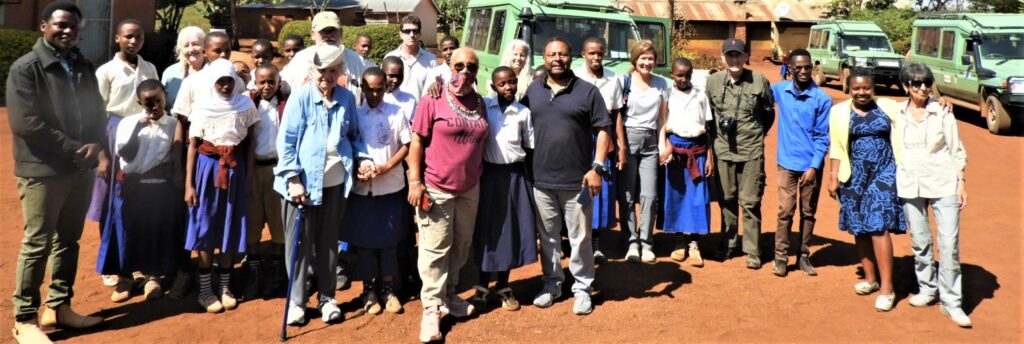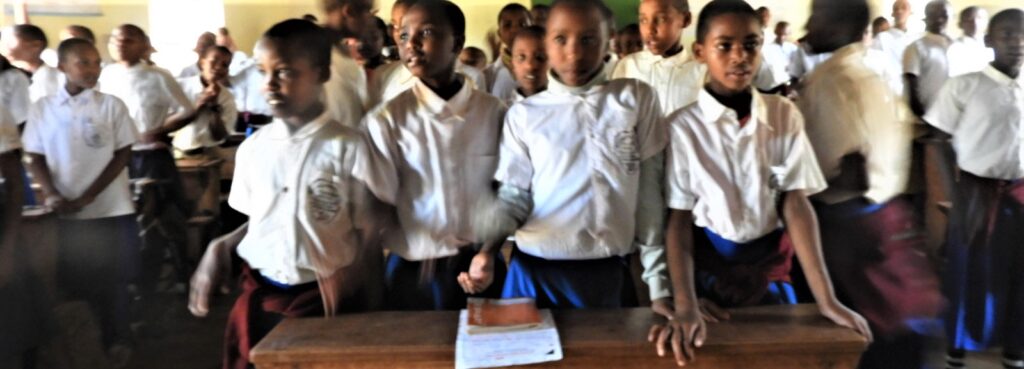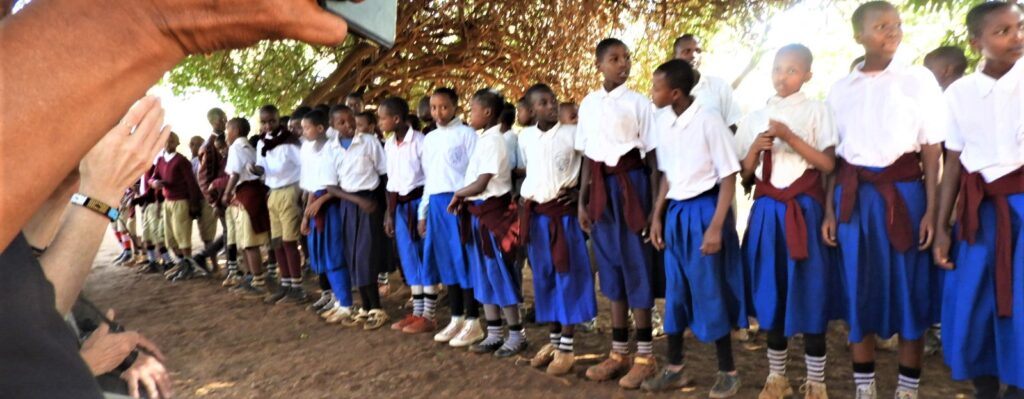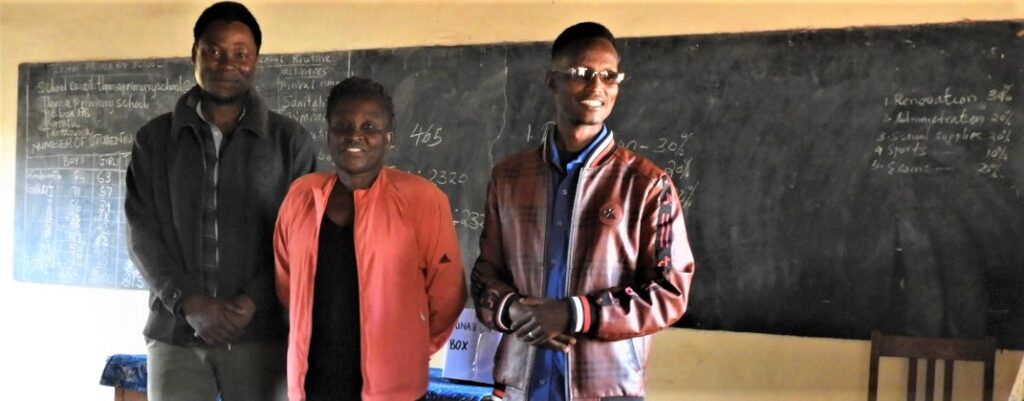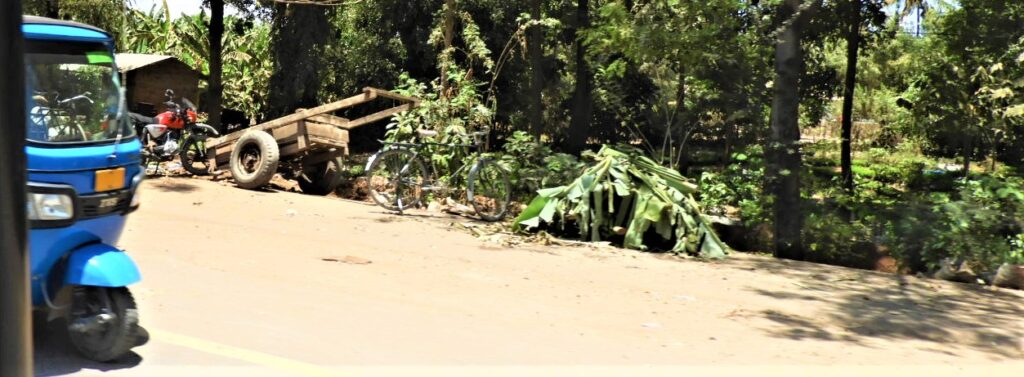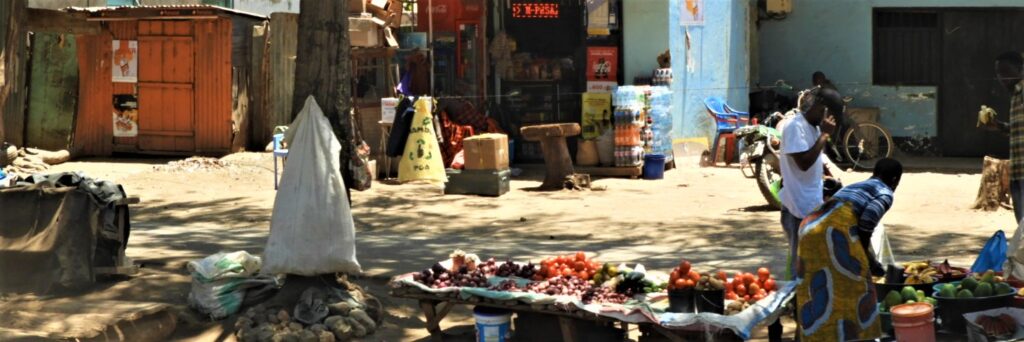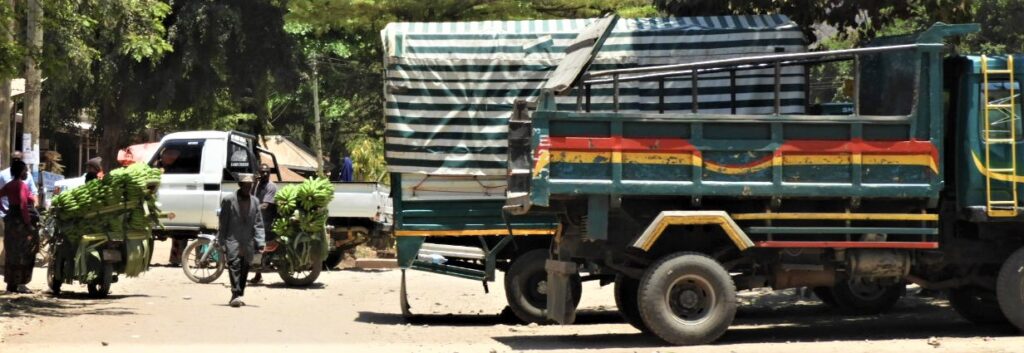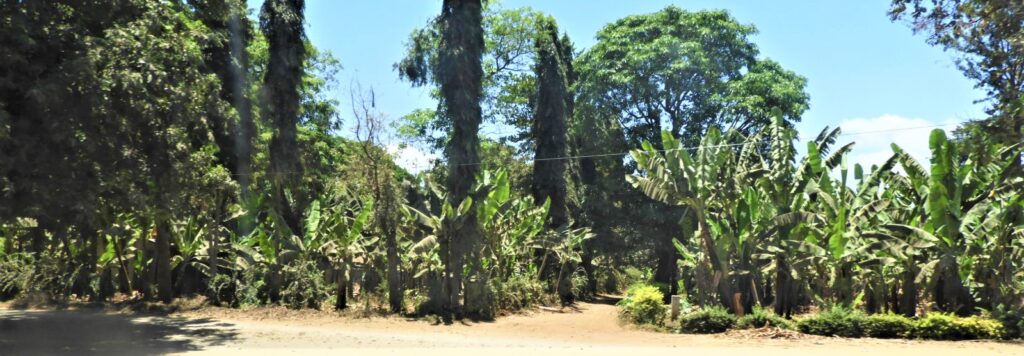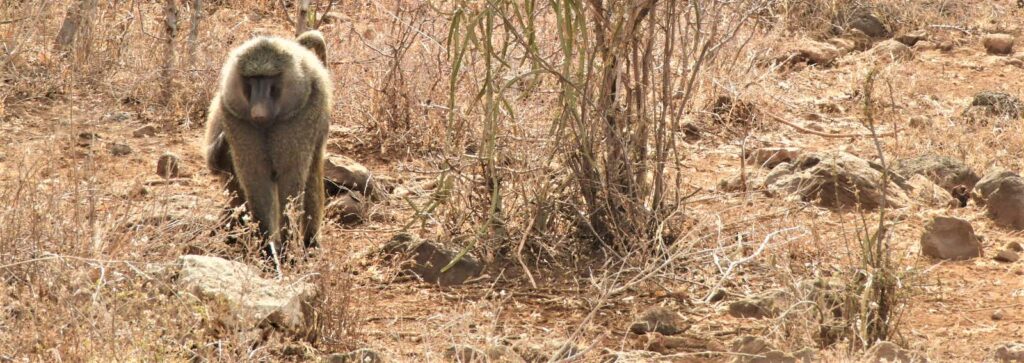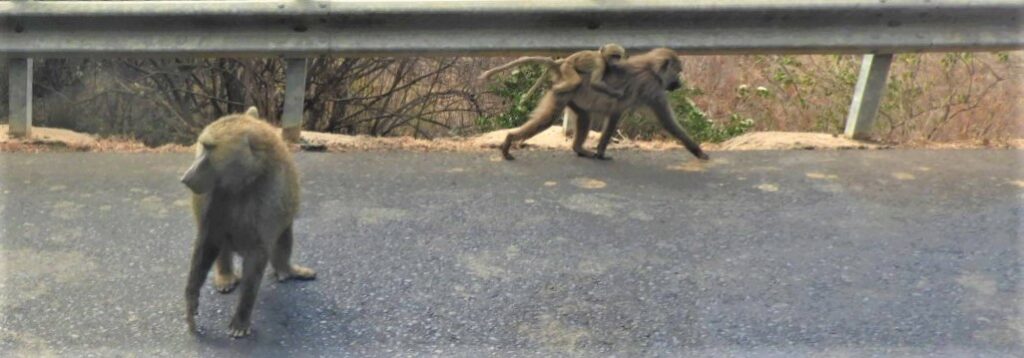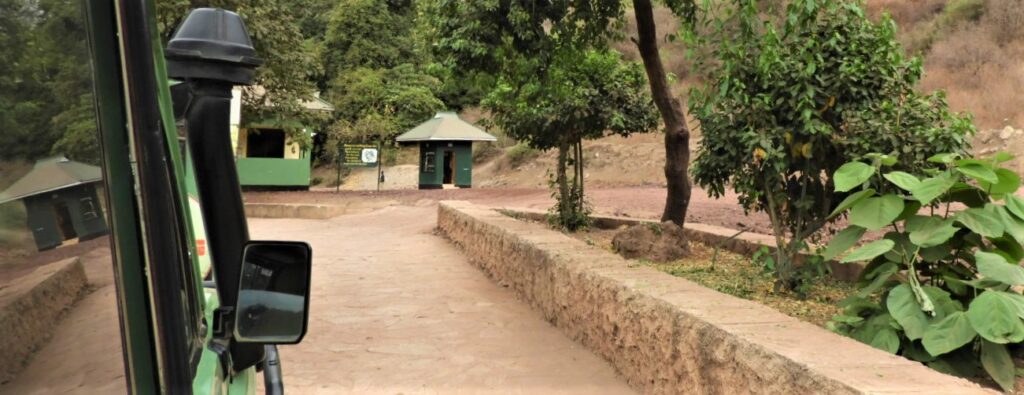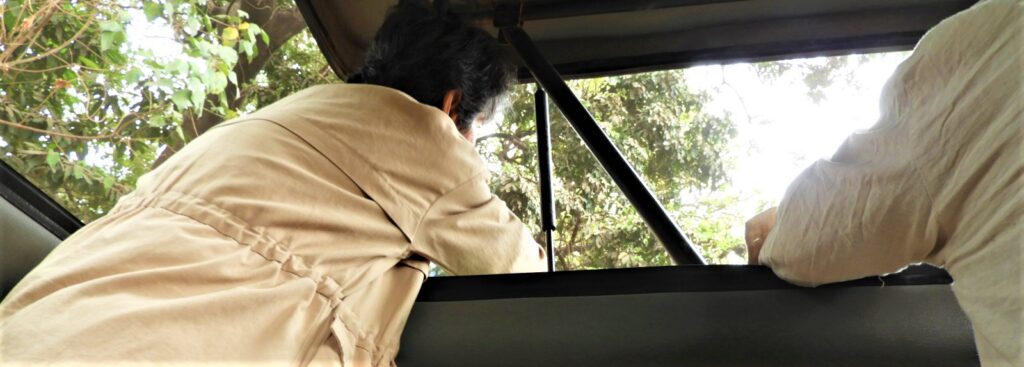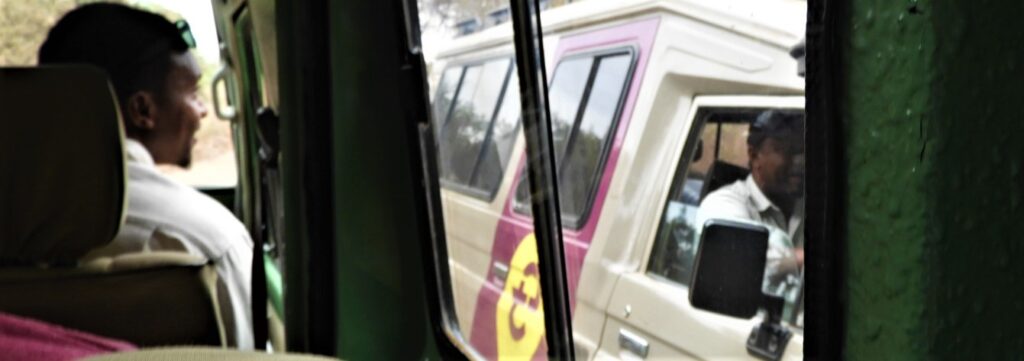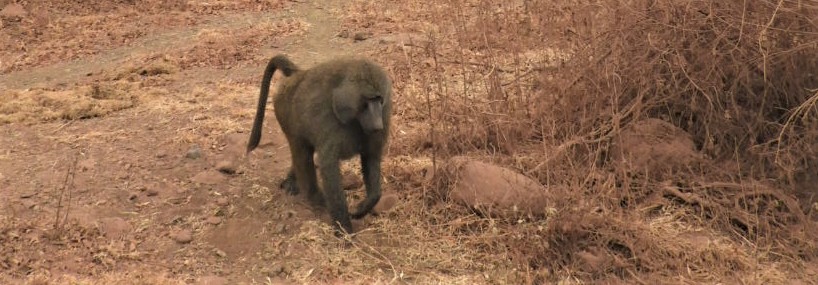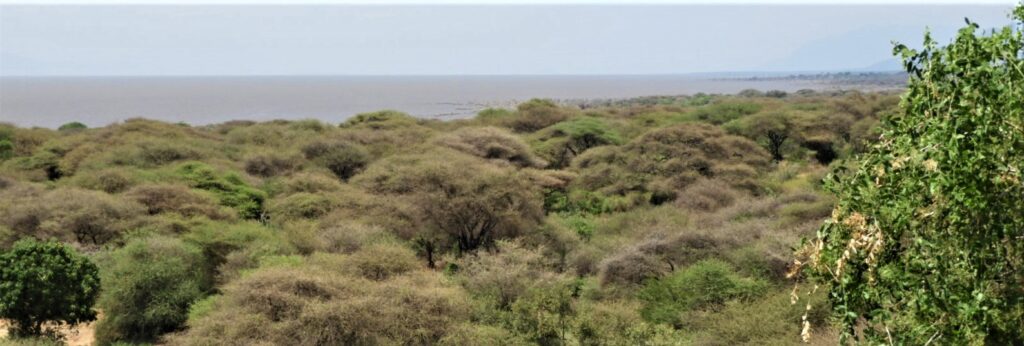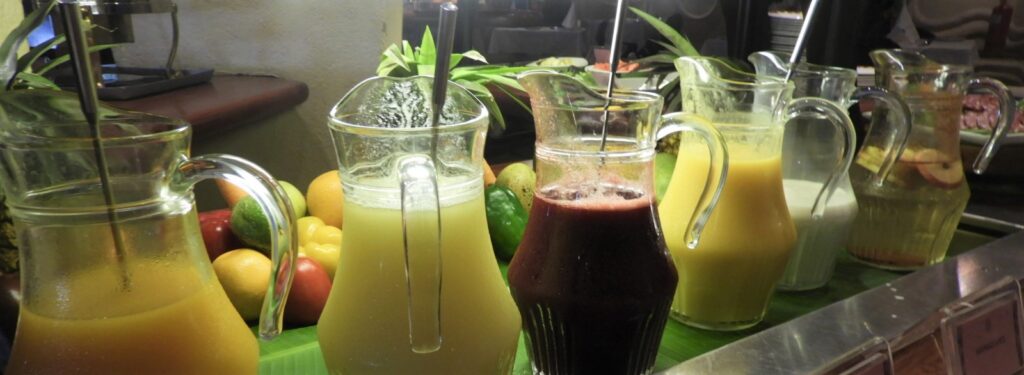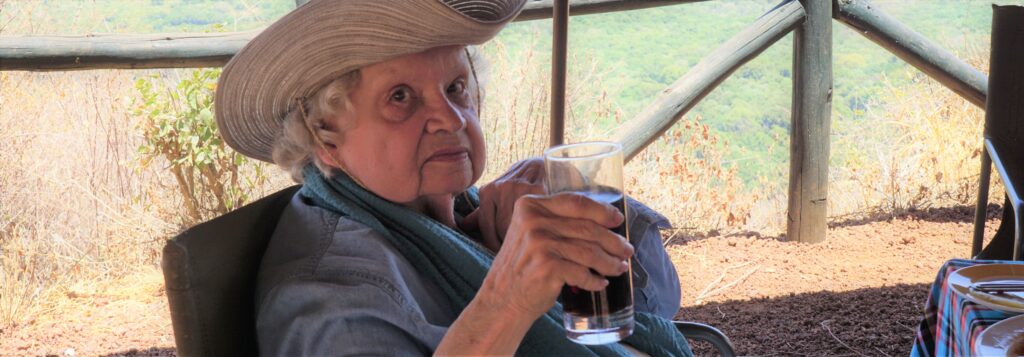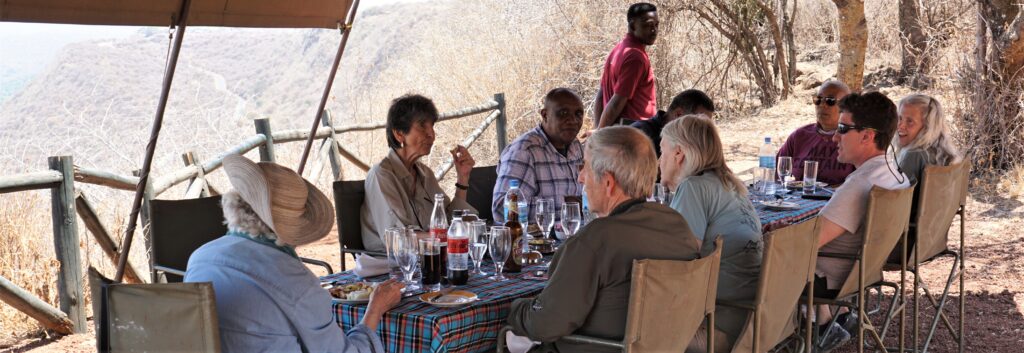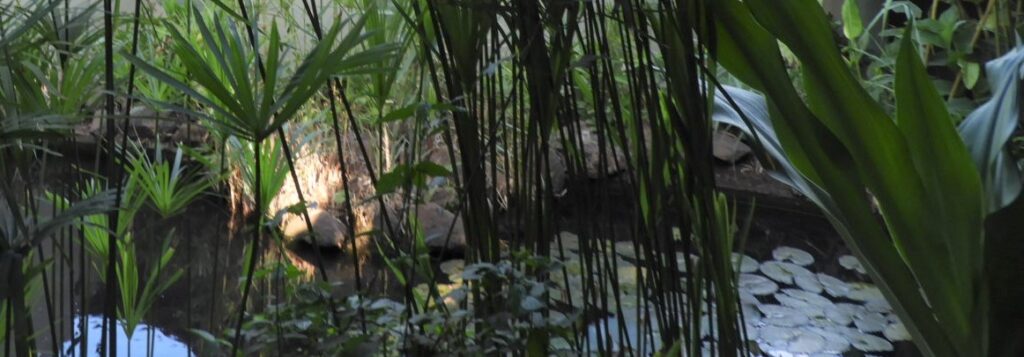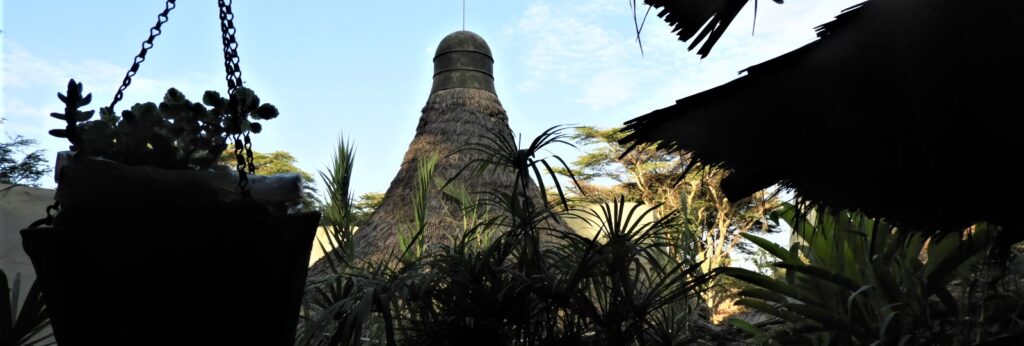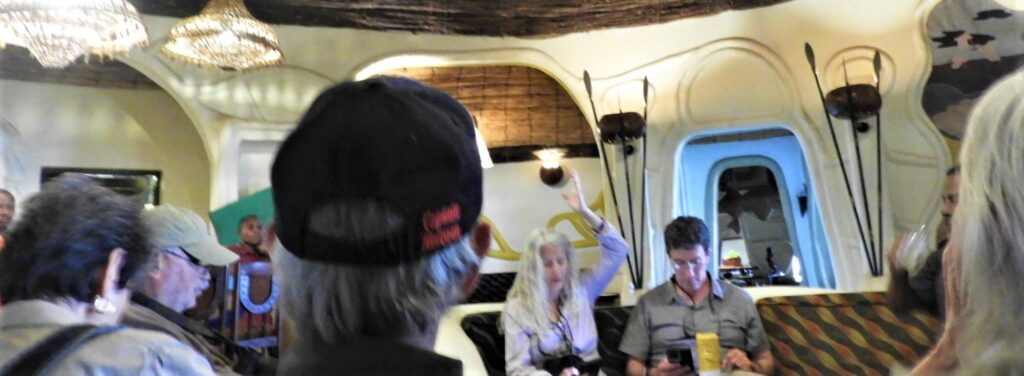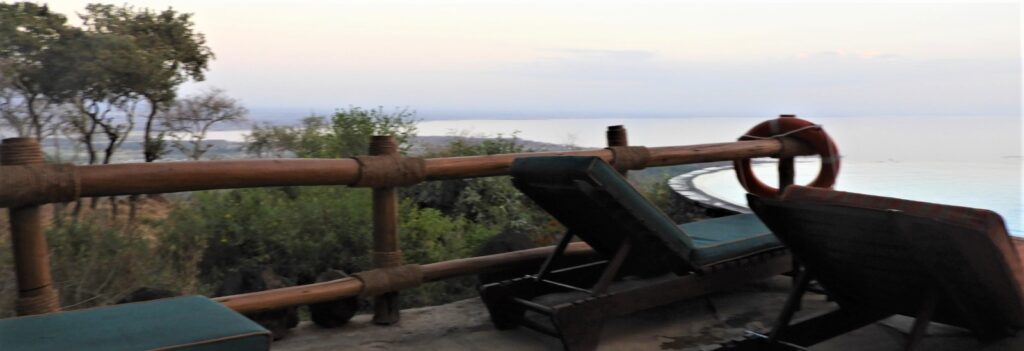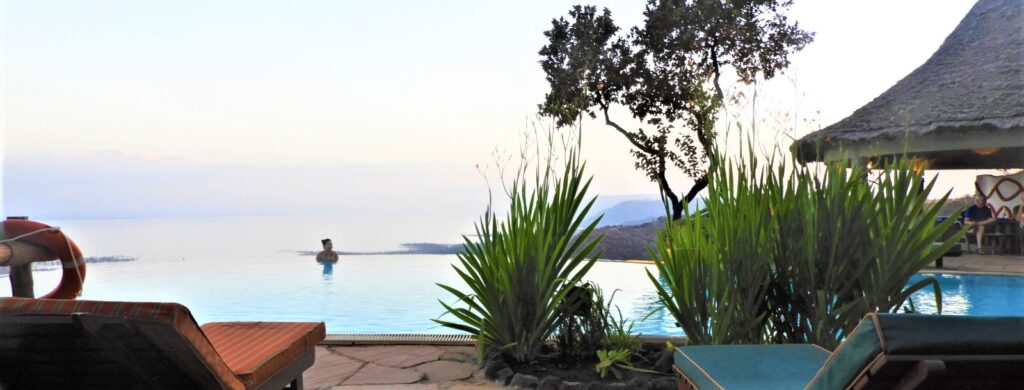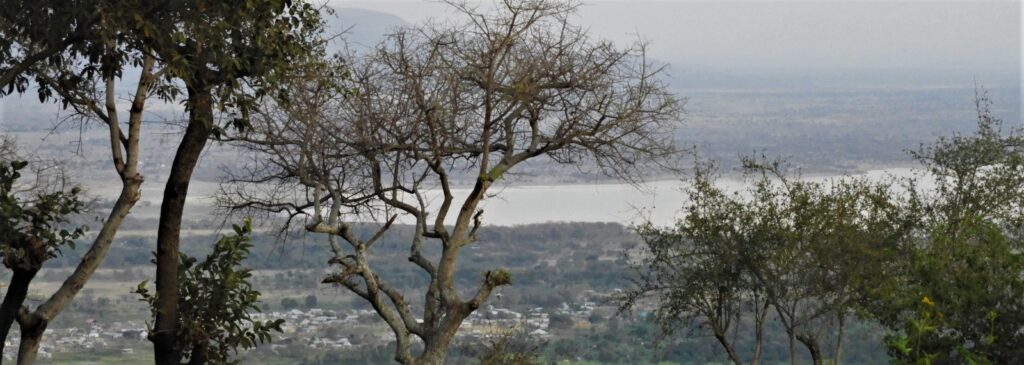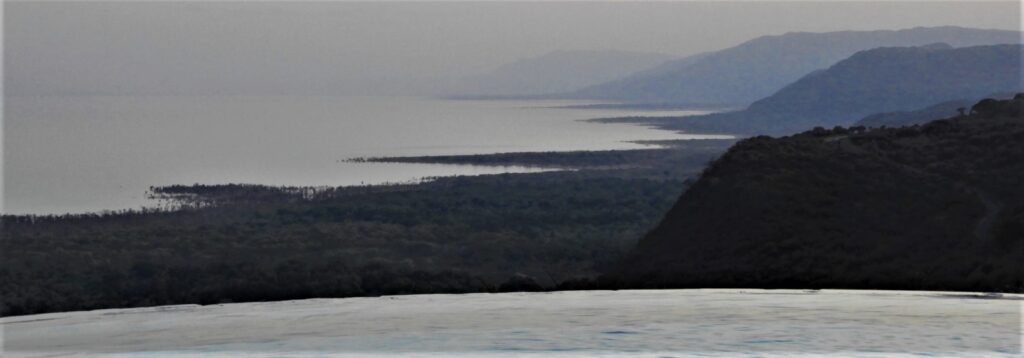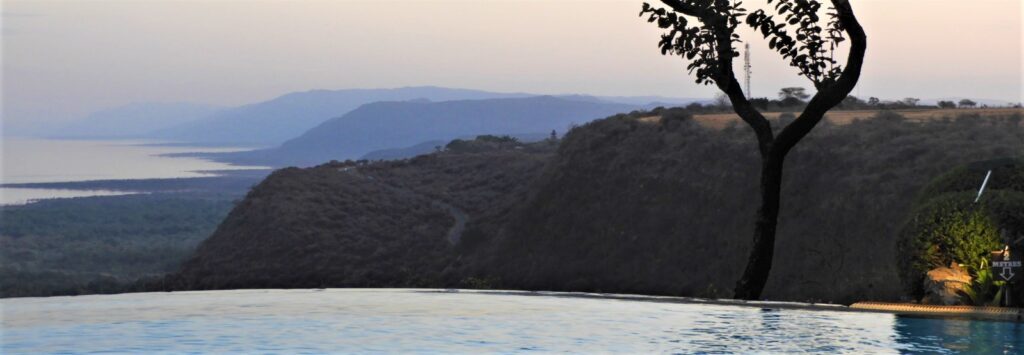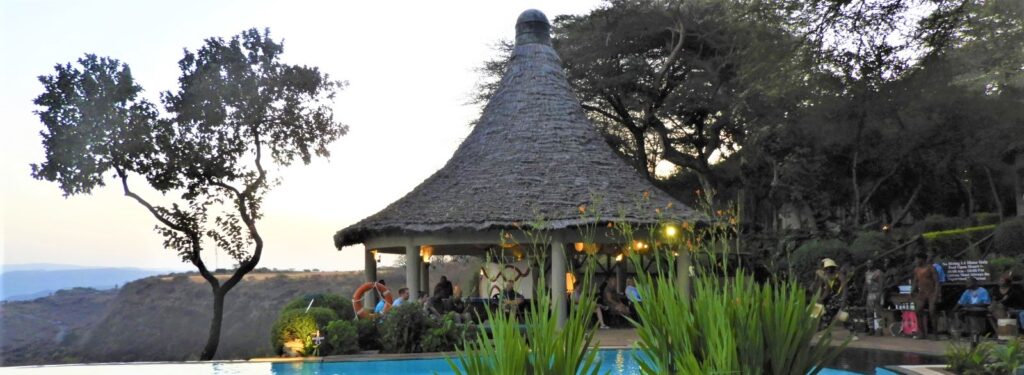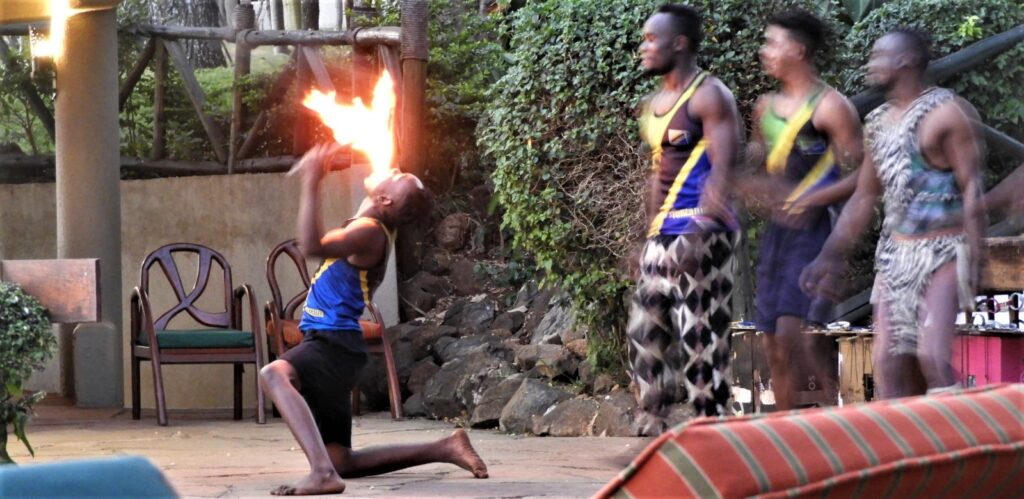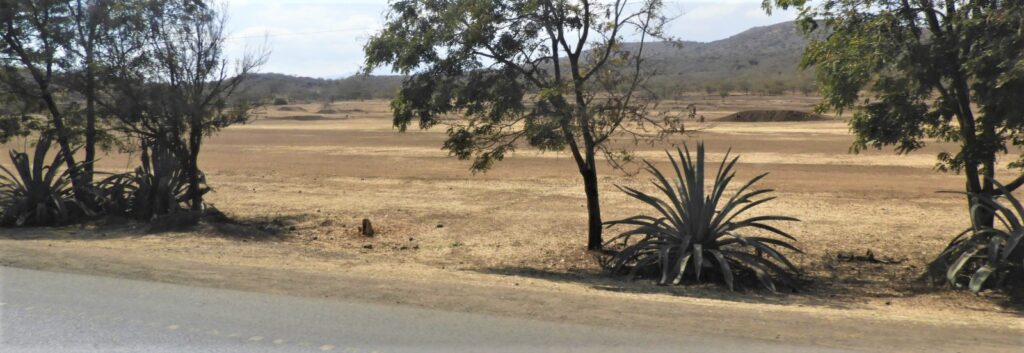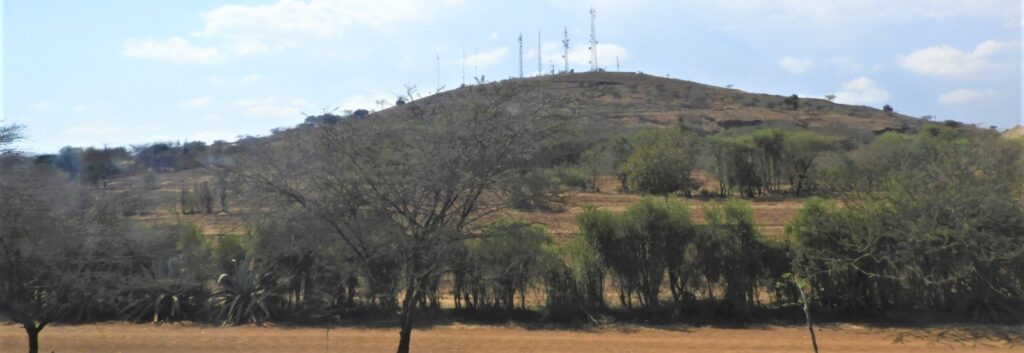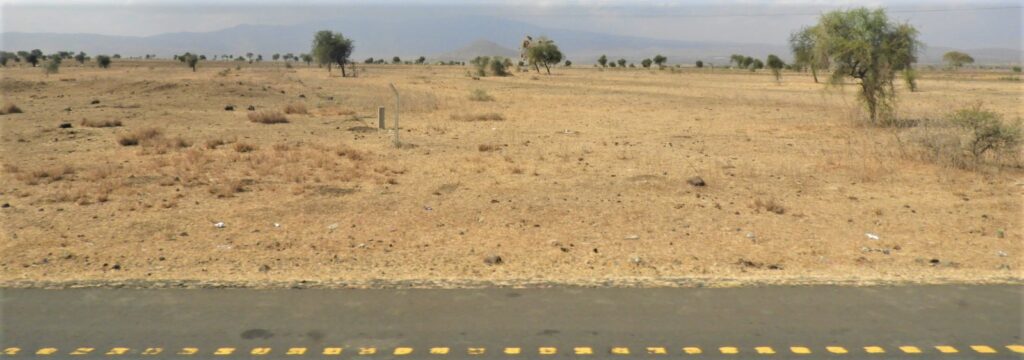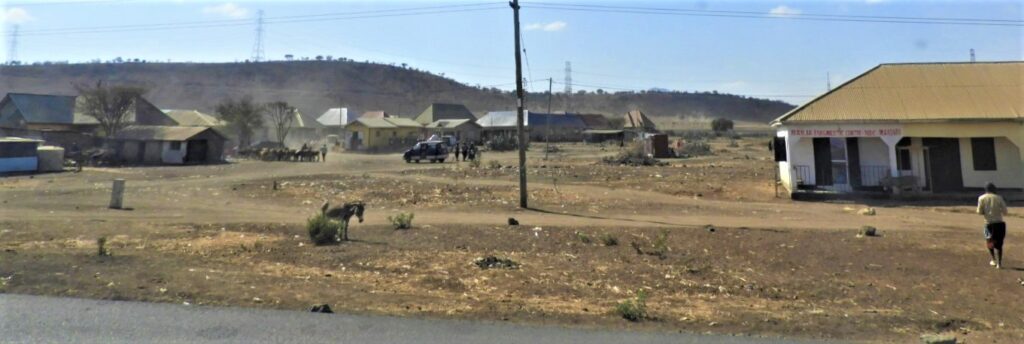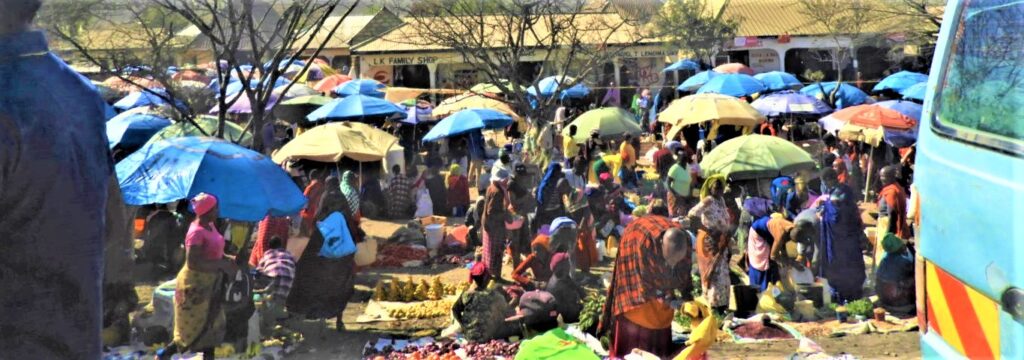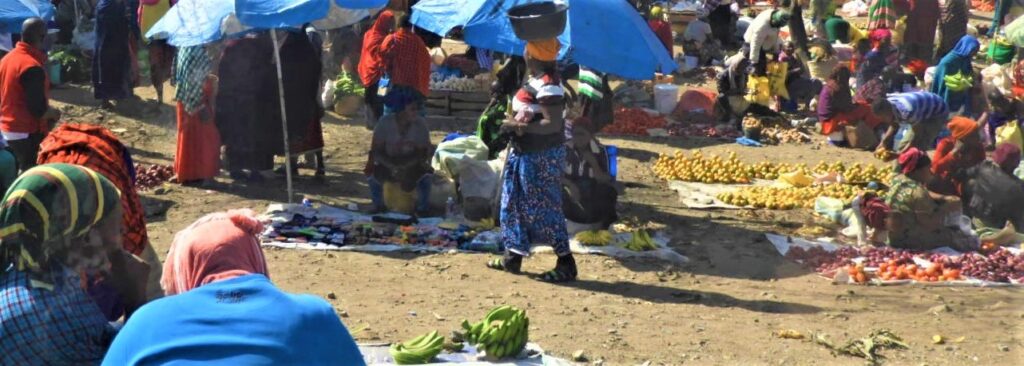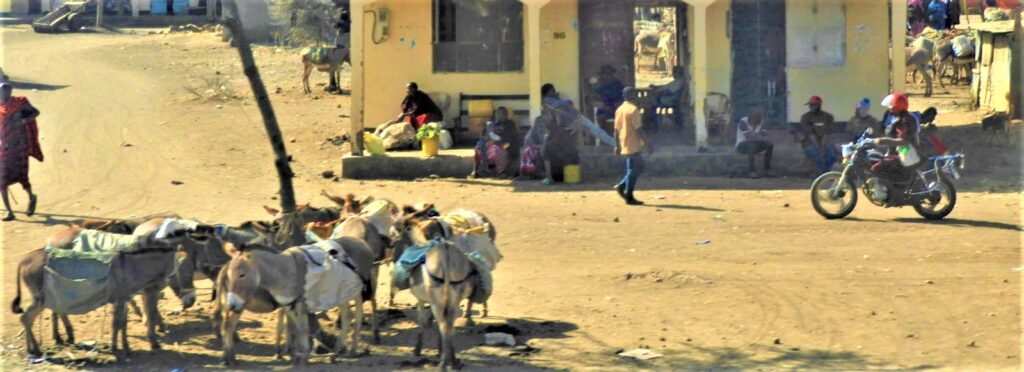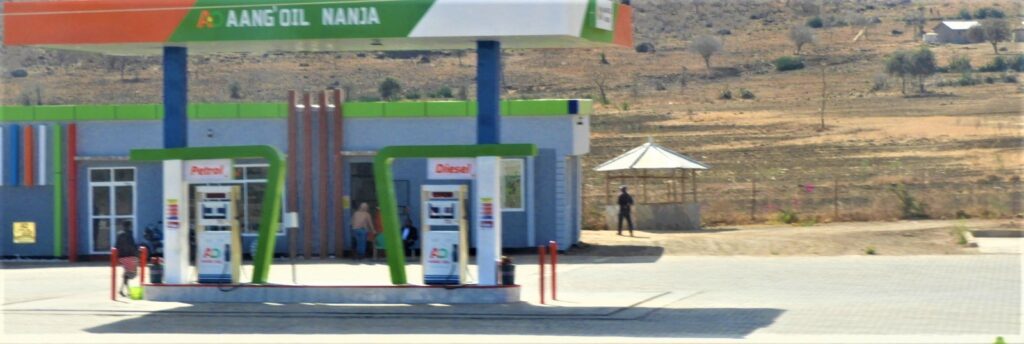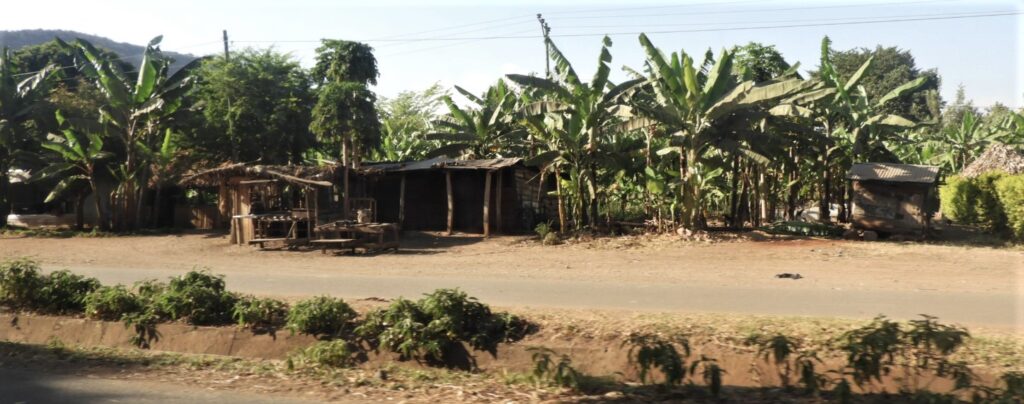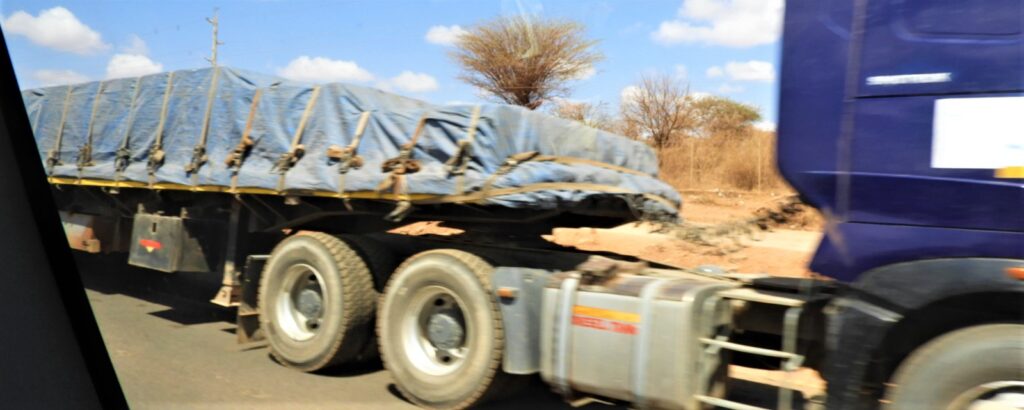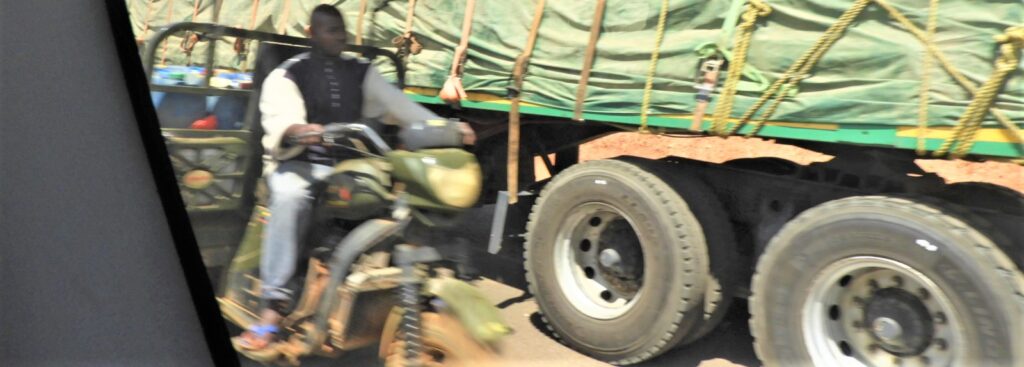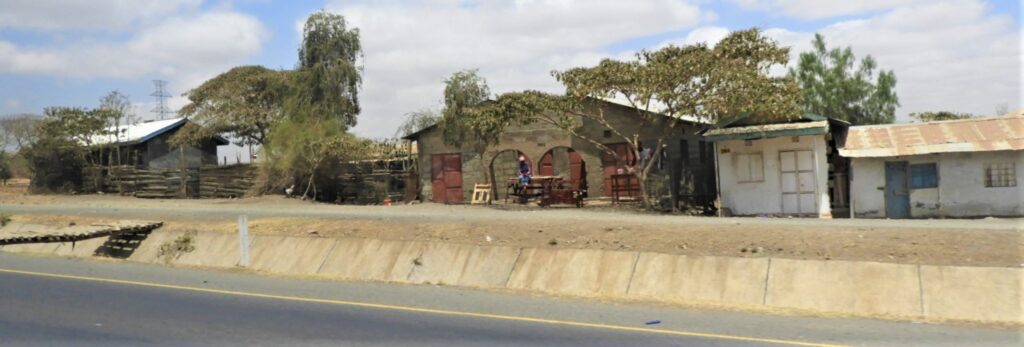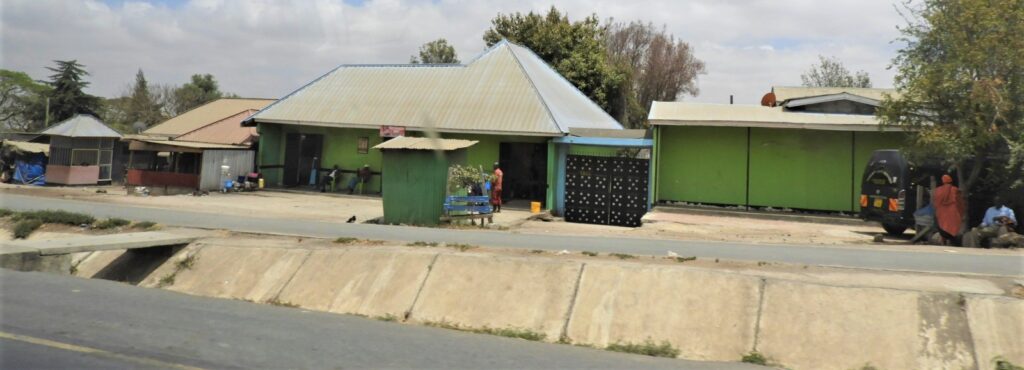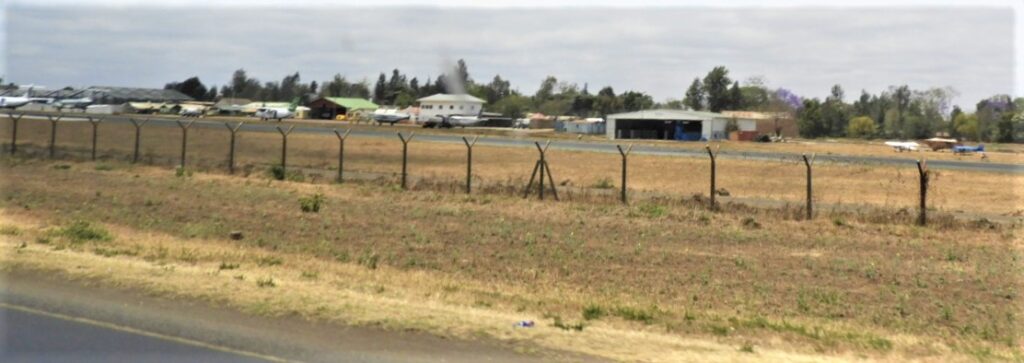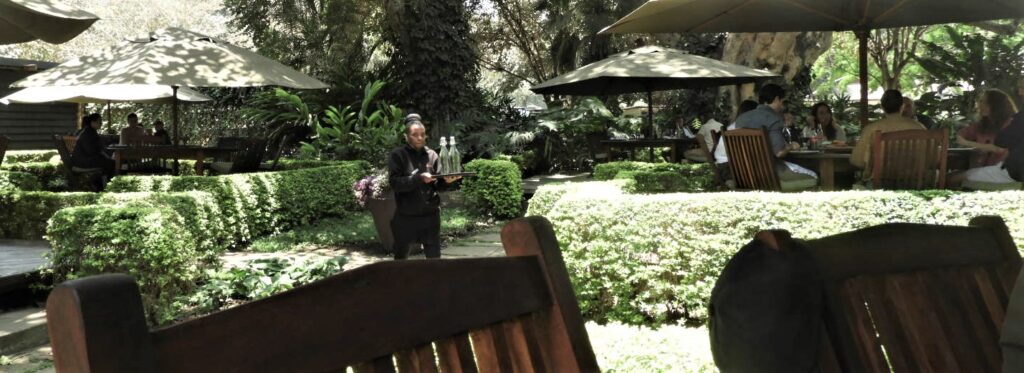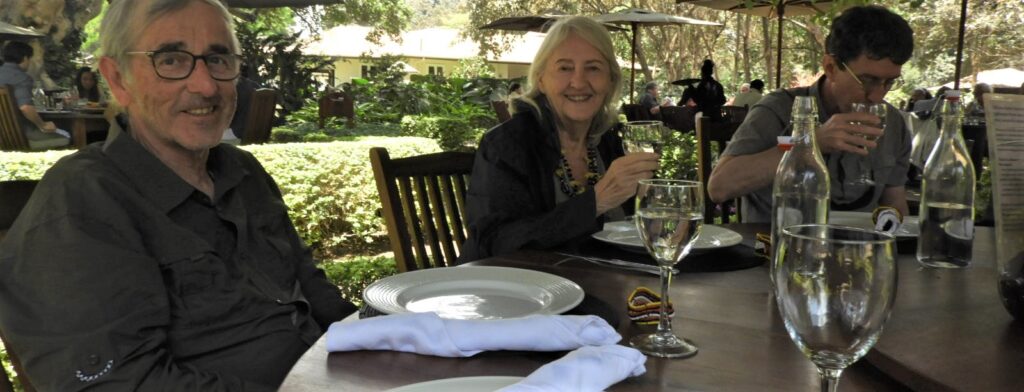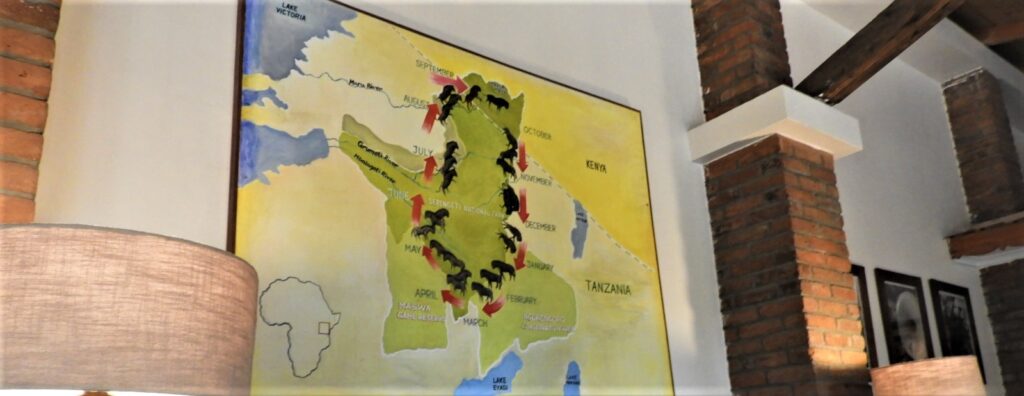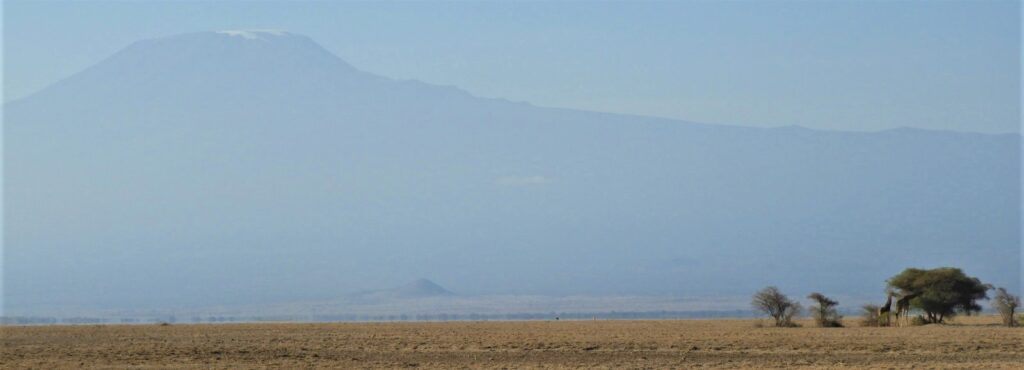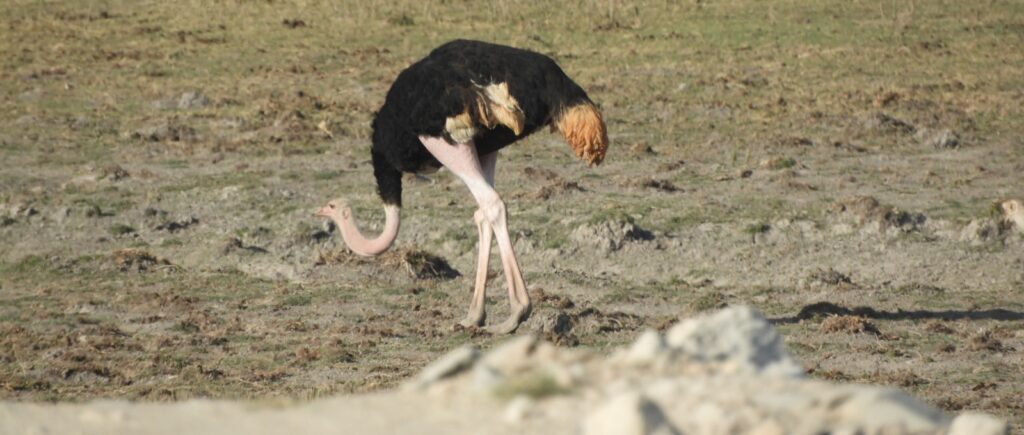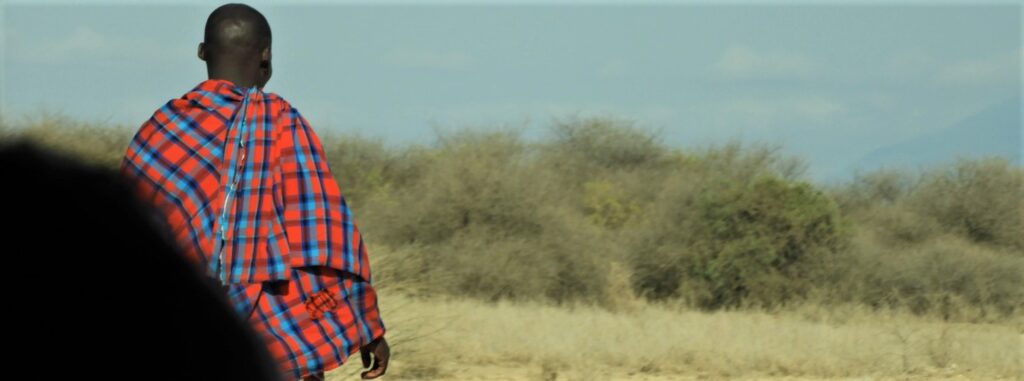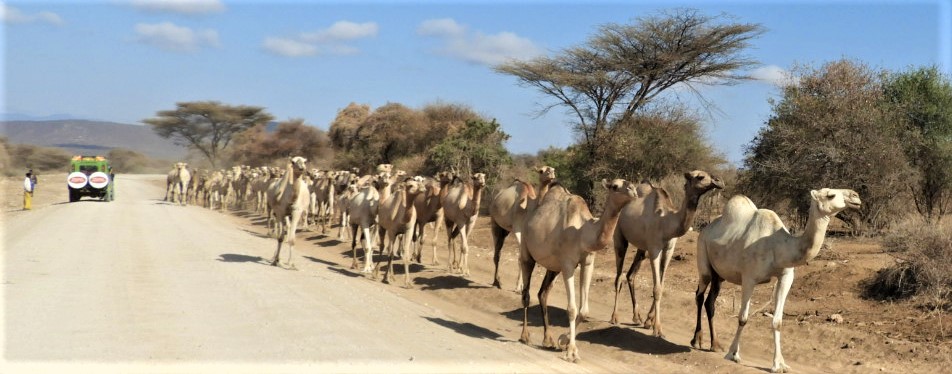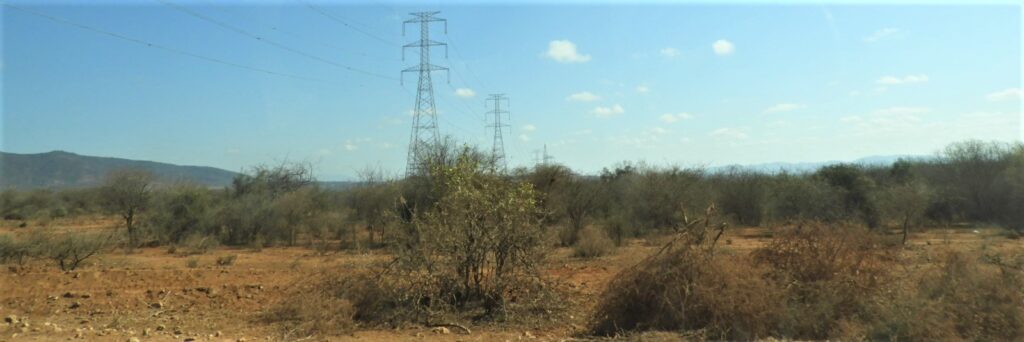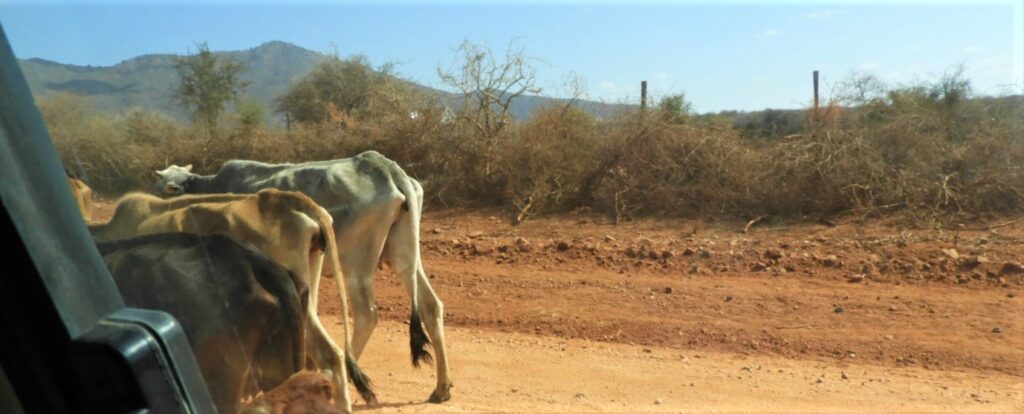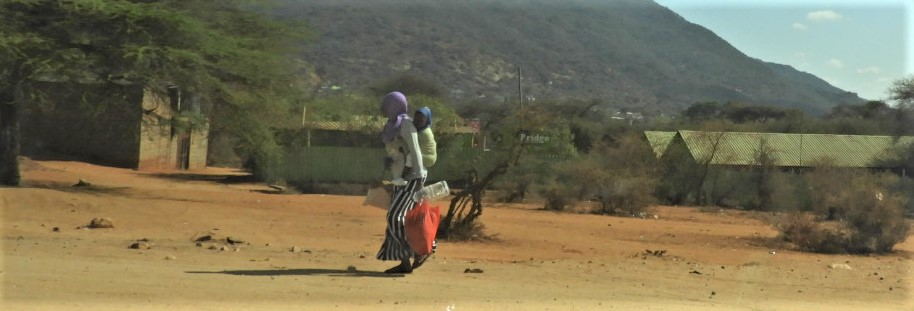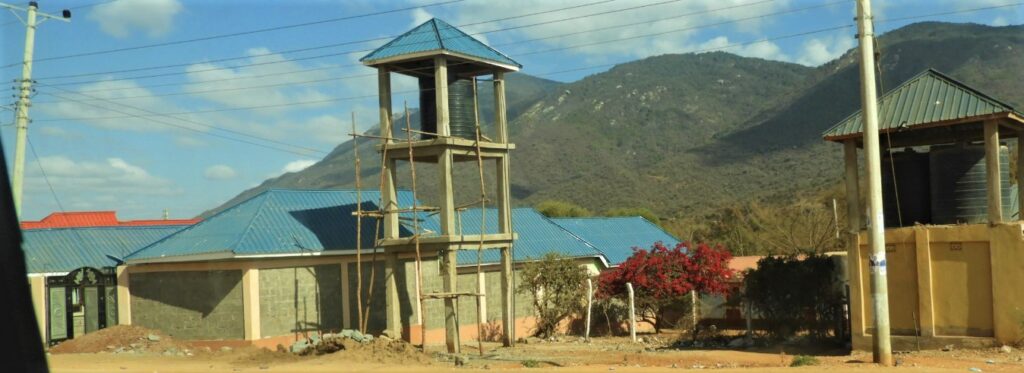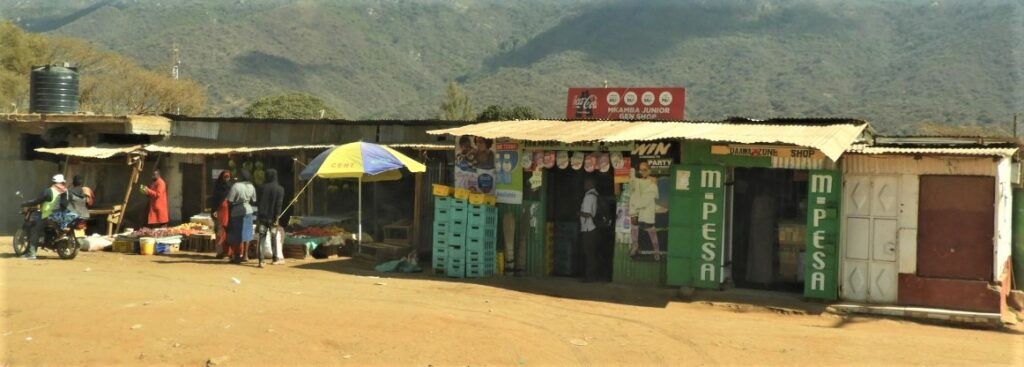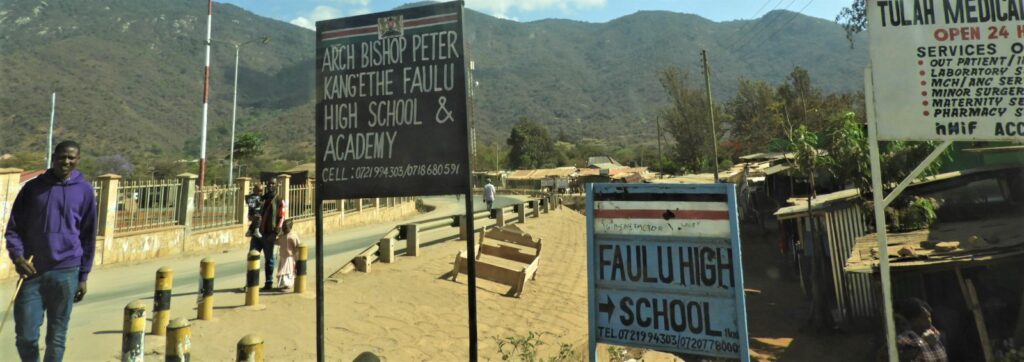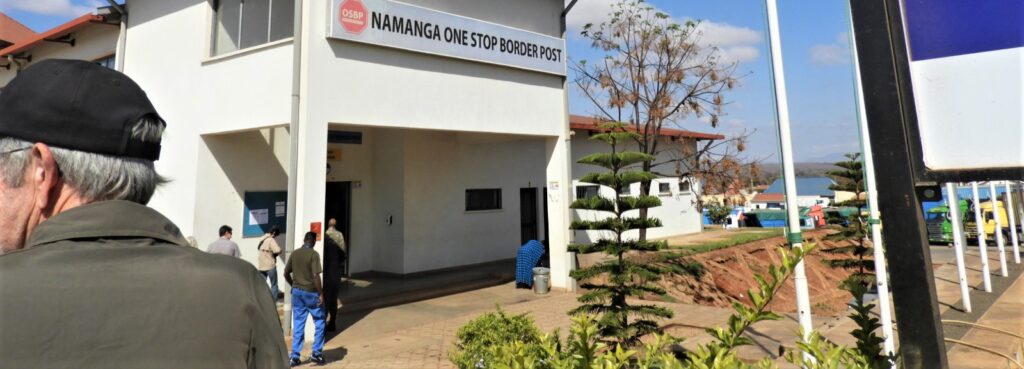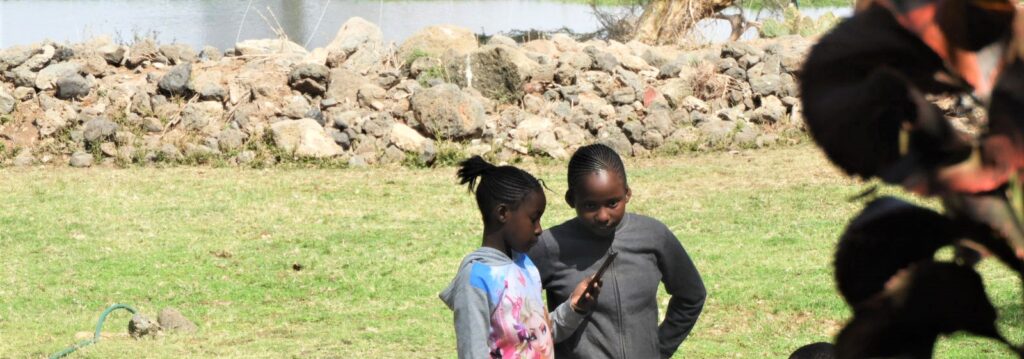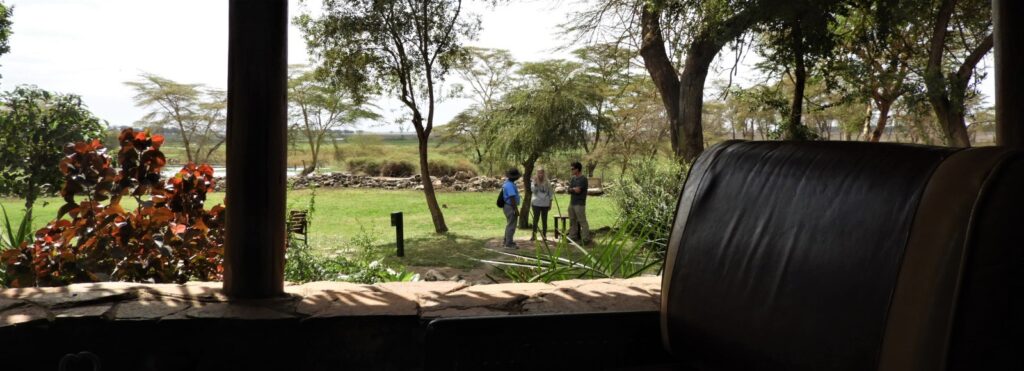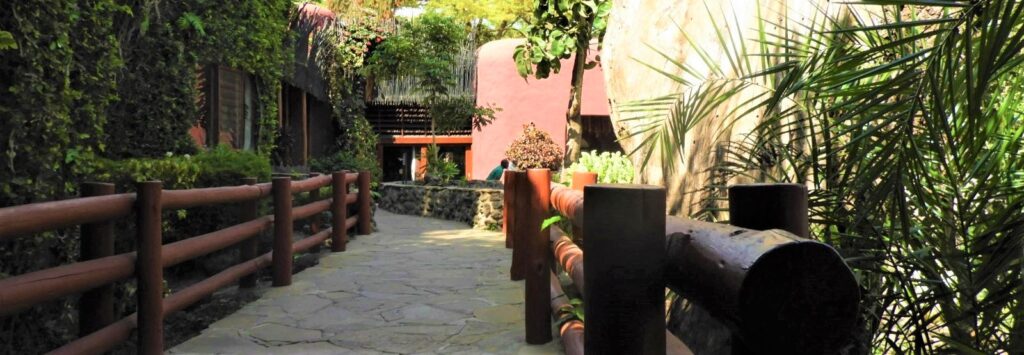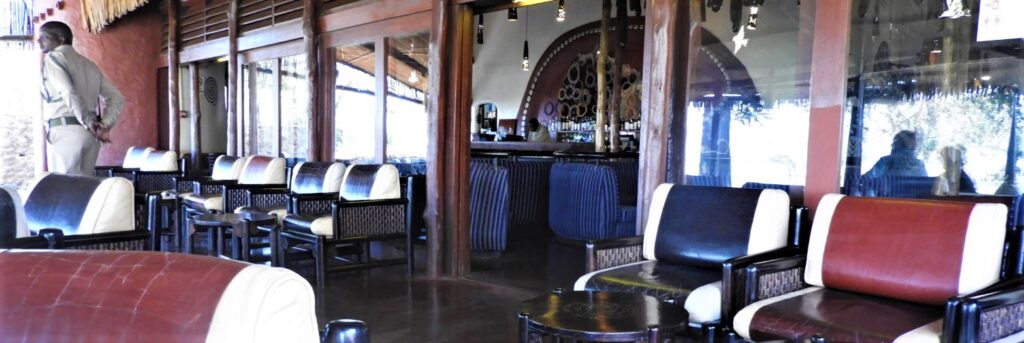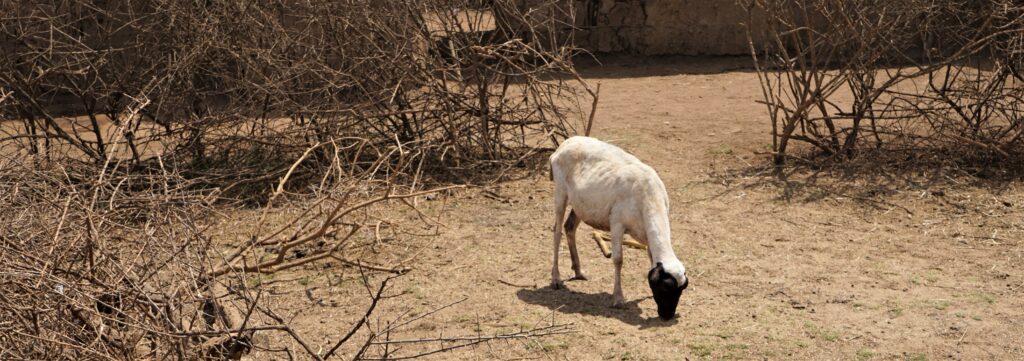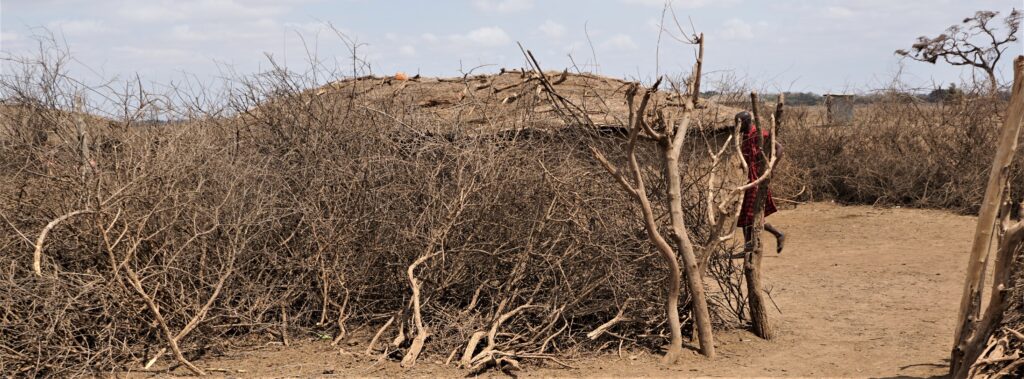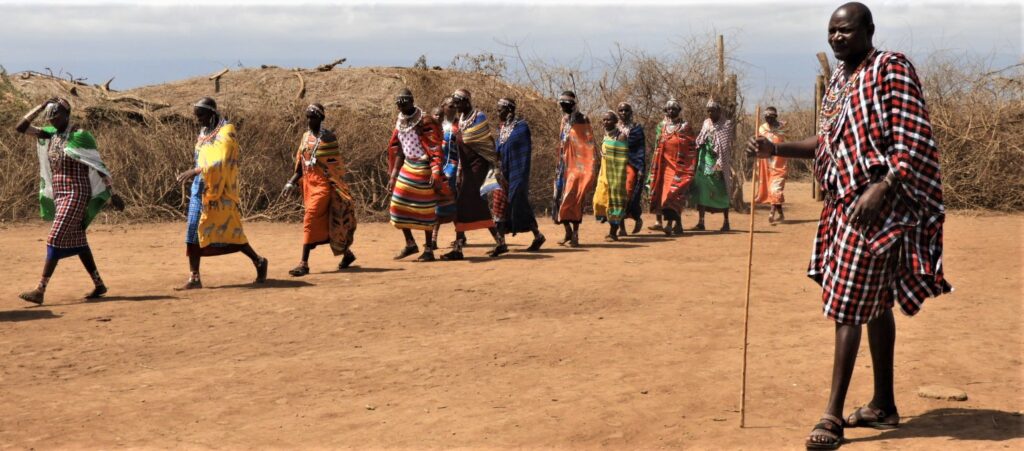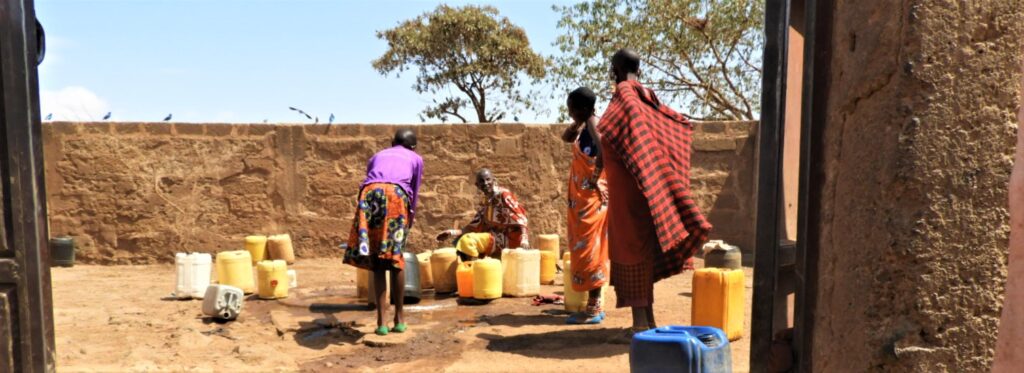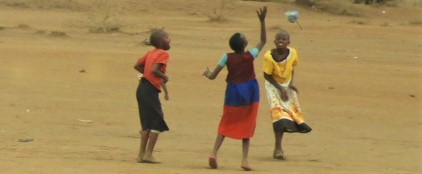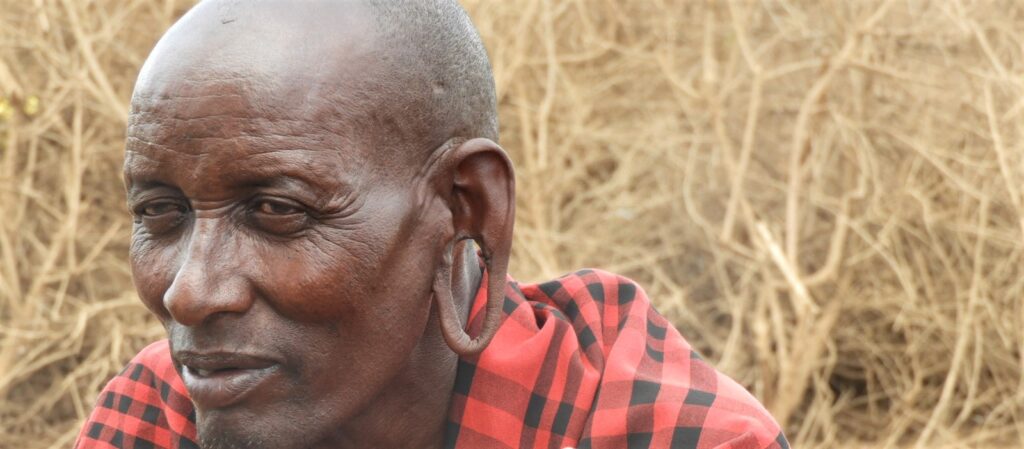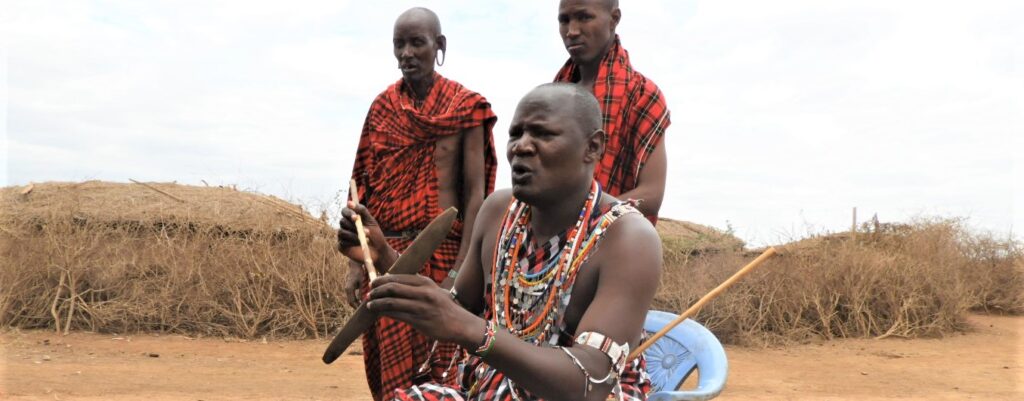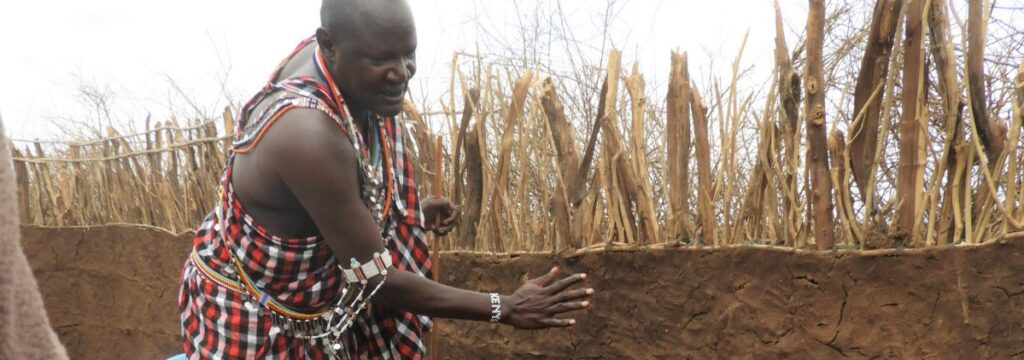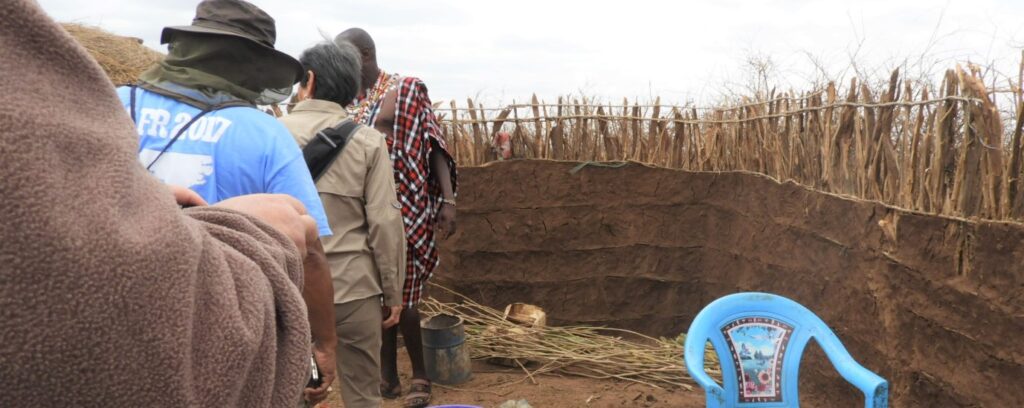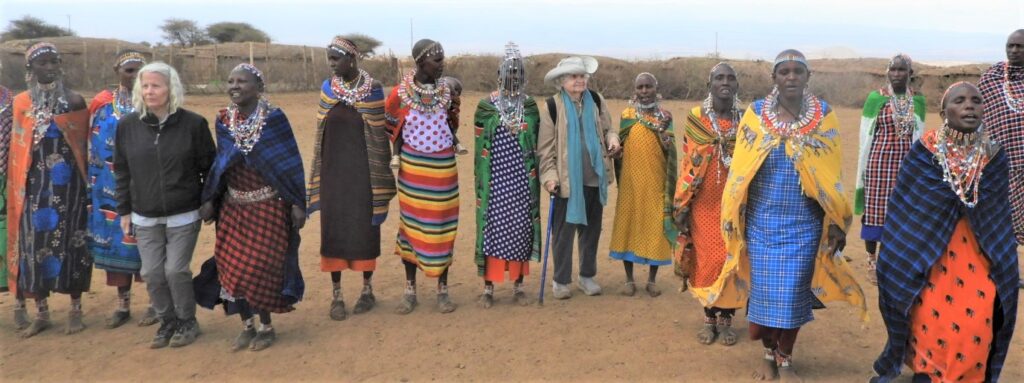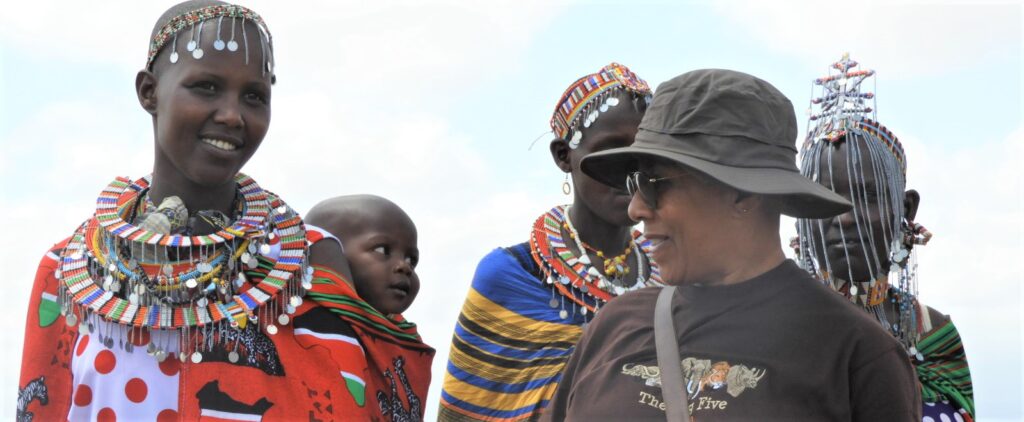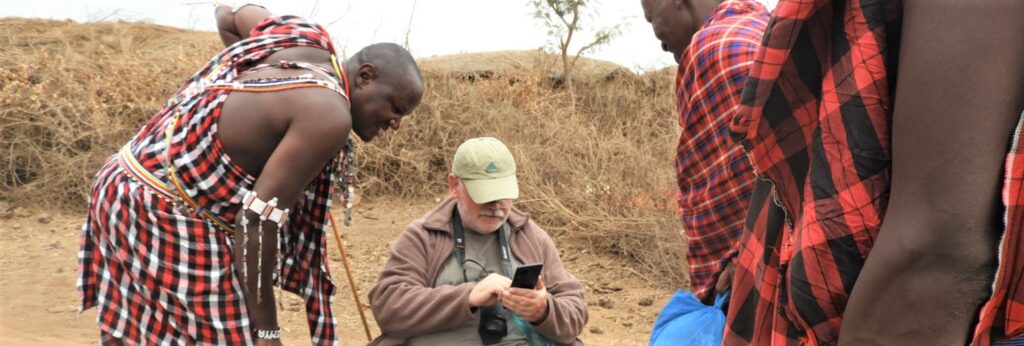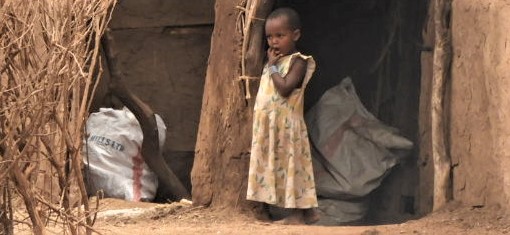‘African Safari + Iceland’ Category
» posted on Tuesday, September 20th, 2022 by Linda Lou Burton
Smiles At Tloma
Linda Lou Burton posting from Tloma Primary School, Karatu, Tanzania– Smiles. That’s the only word needed to describe our afternoon at Tloma Primary School, where our group of nine, plus two people from another Globus tour, visited this afternoon. Immanuel was the young fellow who ran out and took my hand, escorting me into the building with a sweet smile, walking as slowly alongside me as I needed. Inside, after a round of singing and story-telling from the children, led by a smiling teacher weaving her way around the room (if ever I’d had a teacher like that I’d know how to dance today!), we were invited to talk to the 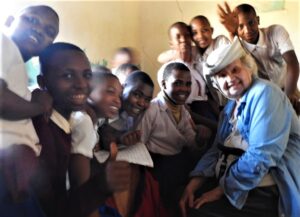 students about our part of the world, and to answer any questions they might have. Then, best of all, we got to sit with the students. My group of smiling boys called me Beebe (Grandma) and showed me their workbooks, pointing to the Swahili words for different family members: Mama and Baba for parents, on down the
students about our part of the world, and to answer any questions they might have. Then, best of all, we got to sit with the students. My group of smiling boys called me Beebe (Grandma) and showed me their workbooks, pointing to the Swahili words for different family members: Mama and Baba for parents, on down the 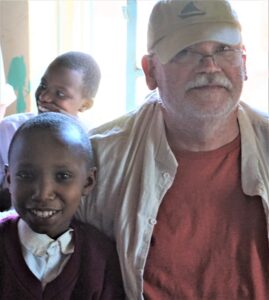 list. The singing show continued outside; the smiling did too; smiles exchanged, back and forth and around again. The adults had a sit down visit with three of the teachers after that, the blackboard behind filled with the facts of life: 815 students, 14 teachers. We were seated in the wooden desks they use; names of donors inscribed on each. Yes, the school needs help. Nothing there to smile about, except the fact that Tloma Giving is in place as a gateway for people to do just that. I’m choosing to send money to Tloma to be used for school supplies, thinking of those boys, and their notebooks, and their smiles. Photos of our visit below; see what I mean?
list. The singing show continued outside; the smiling did too; smiles exchanged, back and forth and around again. The adults had a sit down visit with three of the teachers after that, the blackboard behind filled with the facts of life: 815 students, 14 teachers. We were seated in the wooden desks they use; names of donors inscribed on each. Yes, the school needs help. Nothing there to smile about, except the fact that Tloma Giving is in place as a gateway for people to do just that. I’m choosing to send money to Tloma to be used for school supplies, thinking of those boys, and their notebooks, and their smiles. Photos of our visit below; see what I mean?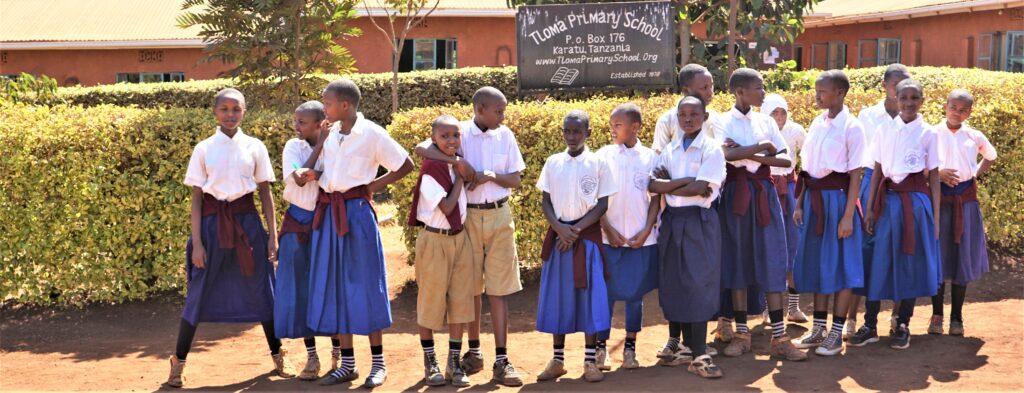
Tloma Primary School https://tlomaprimaryschool.org/about/
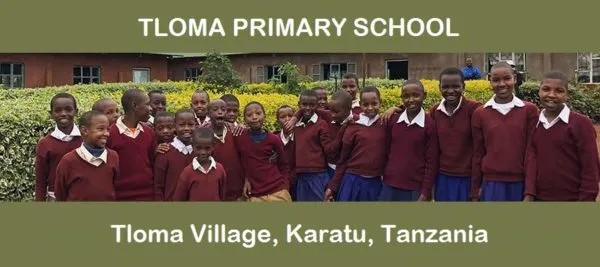
 Tloma Primary School is located in Tloma Village, a small community on the outskirts of Karatu, Arusha, Tanzania, situated low on the outer slope of the Ngorongoro Crater. Tloma means ‘hill’ in the Iraqw language, the native language of many people in the Village. The school was established in 1978 and has grown from a few students to the present enrollment of 815 children in grades Kindergarten through 7. The school currently has 14 teachers. The smallest class size is 67 students; the largest, Kindergarten, is 144 students. Children are introduced to the national language, Swahili, in Kindergarten and subjects through Class 7 are taught in Swahili. The English class begins in Class 4; once students graduate from Tloma Primary School to attend secondary school, all classes are taught in English.
Tloma Primary School is located in Tloma Village, a small community on the outskirts of Karatu, Arusha, Tanzania, situated low on the outer slope of the Ngorongoro Crater. Tloma means ‘hill’ in the Iraqw language, the native language of many people in the Village. The school was established in 1978 and has grown from a few students to the present enrollment of 815 children in grades Kindergarten through 7. The school currently has 14 teachers. The smallest class size is 67 students; the largest, Kindergarten, is 144 students. Children are introduced to the national language, Swahili, in Kindergarten and subjects through Class 7 are taught in Swahili. The English class begins in Class 4; once students graduate from Tloma Primary School to attend secondary school, all classes are taught in English.
The School Motto: Elimu ni ufunguo wa maisha (Education is the key of life).
Students begin each day by lining up outside on the playground and singing the patriotic song “Tanzania Nakupenda Kwa Moyo Wote” (Tanzania I Love You With All My Heart).
Watch the students sing – video https://tlomagiving.org/?page_id=446
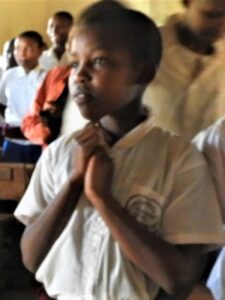 Tloma Giving is a U.S. non-profit educational and charitable corporation under Section 501(c)(3) of the Internal Revenue Service Code. The purpose of Tloma Giving is to provide support to foster the health, education, social, and economic development of the residents and families of the low-income and underserved Tloma region of the Karatu District, Arusha, Tanzania. We provide funding and support for facilities, training, supplies, and personnel, designed to improve educational opportunities for the children of the Tloma region. For students we provide scholarships, help purchase school uniforms and supplies, and help fund school lunches for students. For the school we help the school purchase teaching supplies and assist in capital improvements.
Tloma Giving is a U.S. non-profit educational and charitable corporation under Section 501(c)(3) of the Internal Revenue Service Code. The purpose of Tloma Giving is to provide support to foster the health, education, social, and economic development of the residents and families of the low-income and underserved Tloma region of the Karatu District, Arusha, Tanzania. We provide funding and support for facilities, training, supplies, and personnel, designed to improve educational opportunities for the children of the Tloma region. For students we provide scholarships, help purchase school uniforms and supplies, and help fund school lunches for students. For the school we help the school purchase teaching supplies and assist in capital improvements.
» posted on Tuesday, September 20th, 2022 by Linda Lou Burton
Quickies: The Town
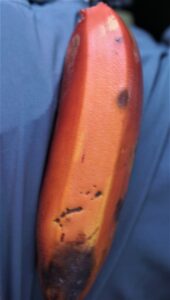 Linda Lou Burton posting from Mto Wa Mbu Village, Tanzania– The Quest For a Red Banana. Willy wanted to gas up the 4×4 and clean the inside a bit more from our morning explosion. Venita needed a bank. I wanted to see more of the banana trees we’d hurried past the night before. And Judy wanted to buy a red banana. Ben mentioned red bananas as something very “Tanzanian,” and Judy immediately said “Wow! Red bananas? Wow! How do they taste? Wow! RED bananas! Let’s go get some!” That’s why Willy turned right out of the Park and drove into Mto Wa Mbu, a touristy town in a handy dandy place for tourists halfway between Mt Kili-Arusha and the Ngorongoro Crater-Serengeti. Like us. The village is a crossroads for locals too; an agricultural hub famous for its crops of rice and bananas – yes, the distinctive RED bananas grow here. Red onions grow here too, as do tomatoes, coconuts, garlic, avocado, beans and more; trucks roll through town hauling the colorful crops. Add to this mix an incredible cultural diversity – 120 tribes live in the area; and the animal migration route — Mto Wa Mbu is in two wildlife corridors; and you can see this little town deserves a Wow!
Linda Lou Burton posting from Mto Wa Mbu Village, Tanzania– The Quest For a Red Banana. Willy wanted to gas up the 4×4 and clean the inside a bit more from our morning explosion. Venita needed a bank. I wanted to see more of the banana trees we’d hurried past the night before. And Judy wanted to buy a red banana. Ben mentioned red bananas as something very “Tanzanian,” and Judy immediately said “Wow! Red bananas? Wow! How do they taste? Wow! RED bananas! Let’s go get some!” That’s why Willy turned right out of the Park and drove into Mto Wa Mbu, a touristy town in a handy dandy place for tourists halfway between Mt Kili-Arusha and the Ngorongoro Crater-Serengeti. Like us. The village is a crossroads for locals too; an agricultural hub famous for its crops of rice and bananas – yes, the distinctive RED bananas grow here. Red onions grow here too, as do tomatoes, coconuts, garlic, avocado, beans and more; trucks roll through town hauling the colorful crops. Add to this mix an incredible cultural diversity – 120 tribes live in the area; and the animal migration route — Mto Wa Mbu is in two wildlife corridors; and you can see this little town deserves a Wow!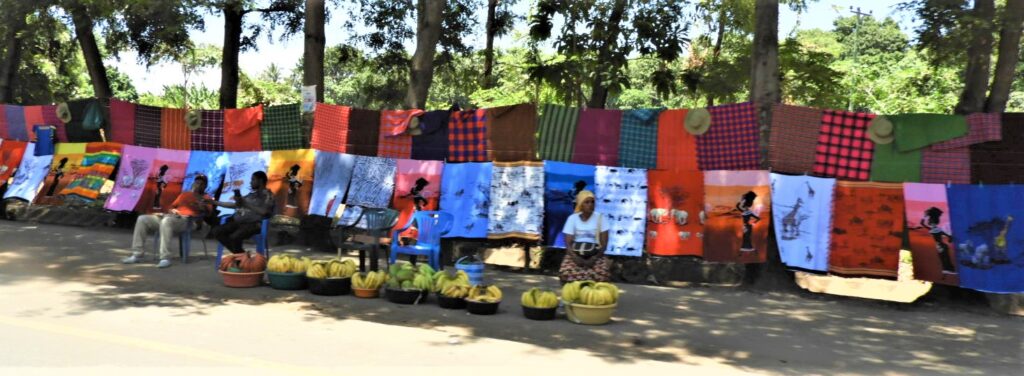
A shame we only had 30 minutes to spend here. Time enough to see the colorful shukas hanging on a line outside the Park, the colorful tuk-tuks ready for a ride, the colorful produce by the basketsful, and the bustle of noisy commerce. Willy took care of the 4×4. Venita took care of her business at the bank. And Judy got her red banana. I saw the banana trees again, another quick wave from the highway, no tuk-tuk ride through the rows. But I did learn this (which I’d wondered about) – Mto Wa Mbu means “river of mosquitoes” in Swahili.
A few photos of our Quickie Visit to the town.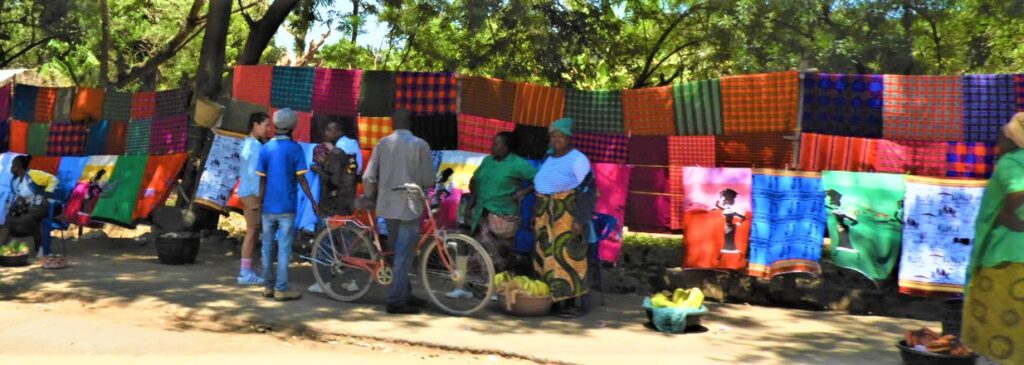
Mto Wa Mbu Village Information
 Mto wa Mbu has a population of 12,000+; 40,000+ in the area. Settled by the Mbugwe, Iraqw, Gorowa, Irangi, Totoga, Chagga and Maasai, the area is the most linguistically diverse and complex in Africa. It is the only place in the continent where the four major African language families – Bantu, Khoisan, Cushitic, and Nilotic – occur together.
Mto wa Mbu has a population of 12,000+; 40,000+ in the area. Settled by the Mbugwe, Iraqw, Gorowa, Irangi, Totoga, Chagga and Maasai, the area is the most linguistically diverse and complex in Africa. It is the only place in the continent where the four major African language families – Bantu, Khoisan, Cushitic, and Nilotic – occur together.
The main water sources in the area are the Mahamoud, Kirurumu and Magadini Rivers; the banana trees are watered by irrigation systems from these rivers. Green bananas grow in nine months; red bananas require one year, and each tree only produces one bunch.
Animals commonly seen in the area on the migration routes include elephant, hippo, giraffe, wildebeest, zebra, gazelle, monkey, and baboon.
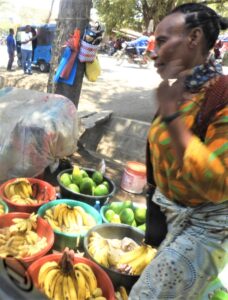 Mto Wa Mbu Village has an active cultural program showing visitors the traditional way of life of the villagers through various activities and a range of community projects. You can visit top spots in the area, taste Tanzanian foods, and experience authentic cultural interaction. A fee is charged for each activity which is then used to support income-generating projects such as the production of energy-efficient stoves and the development of irrigation systems. Students will find the village and its people to be a great resource for information on Tanzania. Everyday topics can be explored as well as more complex subjects like politics, history and culture, wildlife and legends. There are a number of excellent walking, hiking and biking tours offered in the village ranging in length from a few hours to a full day (bikes can be hired in the village).
Mto Wa Mbu Village has an active cultural program showing visitors the traditional way of life of the villagers through various activities and a range of community projects. You can visit top spots in the area, taste Tanzanian foods, and experience authentic cultural interaction. A fee is charged for each activity which is then used to support income-generating projects such as the production of energy-efficient stoves and the development of irrigation systems. Students will find the village and its people to be a great resource for information on Tanzania. Everyday topics can be explored as well as more complex subjects like politics, history and culture, wildlife and legends. There are a number of excellent walking, hiking and biking tours offered in the village ranging in length from a few hours to a full day (bikes can be hired in the village).
- Village Tour – try banana beer, visit a traditional home, learn about Makonde carving
- Village Lunch – enjoy a home-cooked meal the traditional way
- Farm Visit – discover what the villagers grow and how they do it
- Maasai Tour – visit a traditional boma (enclosure), interact with tribal members in various activities
- Maasai Market -browse the weekly market on Thursday afternoons or the monthly market on the 22nd
- Balaa Hill – climb up the Rift Valley Wall for magnificent views and good birding
- Miwaleni Lake and Waterfall – see ancient baobab trees and swim in the pool below the falls
- Lake Manyara – bike through a wildlife corridor to the shores of the lake
Mto Wa Mbu Village https://www.safari.co.za/Tanzania_Travel_Guide-travel/mto-wa-mbu-village.html
» posted on Tuesday, September 20th, 2022 by Linda Lou Burton
Quickies: The Park
Linda Lou Burton posting from Lake Manyara National Park, Tanzania– Tree-climbing lions! That was enough to get up early for. And no long drive to get there; heck, the Park was 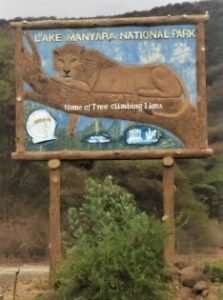 just at the bottom of the hill. Ten minutes to THERE. Out the gate of the Lodge, down the hill a thousand feet; into the gate of the Park. Easy Peasy Game Drive, no sloshing through mudholes and bumping across rocky plains. Just go. Ben the guide, Willy the driver, Otis and Venita row 2, Rick and me row 3, Judy row 4, along with the cooler and water supply. We were packed and ready. First animal spotting going down the hill: baboons, owning the road, babies, early morning action. The Park Gate, fees paid; top up on the 4×4, Judy and Rick standing up, looking out, scanning the trees for lions. Willy chatting with another driver, morning spotting so far? Baboons everywhere, bushes, vines; underbrush thick. Trees, dying trees, dead trees, four buffalo in the mud. Trees, sit and watch
just at the bottom of the hill. Ten minutes to THERE. Out the gate of the Lodge, down the hill a thousand feet; into the gate of the Park. Easy Peasy Game Drive, no sloshing through mudholes and bumping across rocky plains. Just go. Ben the guide, Willy the driver, Otis and Venita row 2, Rick and me row 3, Judy row 4, along with the cooler and water supply. We were packed and ready. First animal spotting going down the hill: baboons, owning the road, babies, early morning action. The Park Gate, fees paid; top up on the 4×4, Judy and Rick standing up, looking out, scanning the trees for lions. Willy chatting with another driver, morning spotting so far? Baboons everywhere, bushes, vines; underbrush thick. Trees, dying trees, dead trees, four buffalo in the mud. Trees, sit and watch 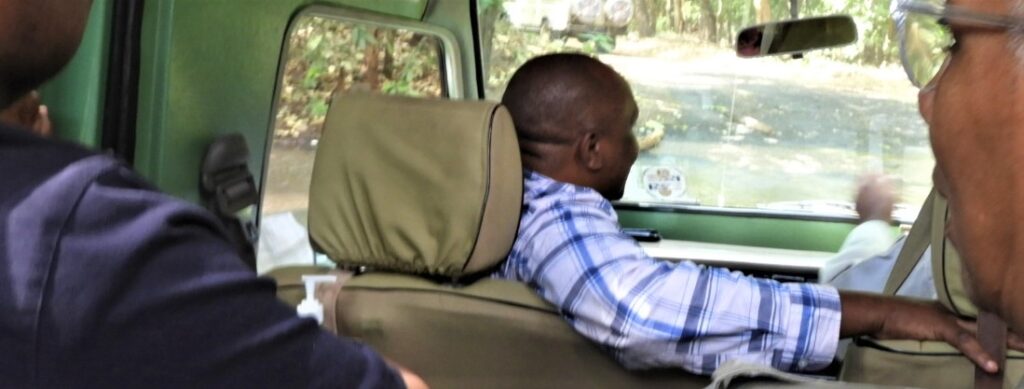 and wait for lions. Ben talking, telling stories, childhood lessons his mother taught. Time dragging. We were bored. Nuts! I remembered the nuts! The chocolate covered already gone; ha, wasabi peanuts left. I passed the bag around. No thanks, no thanks, nobody wanted wasabi heat. Except Willy. And then the scream! “Hot! Hot! Water! Water!” Excitement, finally, and then a brag. As Willy sucked the water down, Rick (Watch this! he said) took a wasabi nut, chewed slowly, swallowed it down. We nodded, impressed (only I was close enough to spot the tears); looked around for lions again. An explosion! In the front of the 4×4! Foam spewing, the windshield turning white, Willy yelling, Ben jumping what was going on??? Is the 4×4 on fire? Did the radiator burst? Should we bail? Willy opened his door, threw the spewing fire extinguisher on the ground. Ben moving fast, is Willy hurt? Is anybody hurt? “I’m okay,” Willy said. “The fire extinguisher blew up.” He began wiping down the inside of the 4×4, busy, cleaning up. “I’m okay,” he said again. “The fire extinguisher just blew up.” We could see, Willy was fine. Ben checked all around the 4×4, got back inside. “The fire extinguisher blew up.” Willy said again. “I don’t know why.” It was very quiet. And then, a burst of laughter, hoots and swoops of laughter, “Oh Willy, Willy, it was that wasabi nut!”
and wait for lions. Ben talking, telling stories, childhood lessons his mother taught. Time dragging. We were bored. Nuts! I remembered the nuts! The chocolate covered already gone; ha, wasabi peanuts left. I passed the bag around. No thanks, no thanks, nobody wanted wasabi heat. Except Willy. And then the scream! “Hot! Hot! Water! Water!” Excitement, finally, and then a brag. As Willy sucked the water down, Rick (Watch this! he said) took a wasabi nut, chewed slowly, swallowed it down. We nodded, impressed (only I was close enough to spot the tears); looked around for lions again. An explosion! In the front of the 4×4! Foam spewing, the windshield turning white, Willy yelling, Ben jumping what was going on??? Is the 4×4 on fire? Did the radiator burst? Should we bail? Willy opened his door, threw the spewing fire extinguisher on the ground. Ben moving fast, is Willy hurt? Is anybody hurt? “I’m okay,” Willy said. “The fire extinguisher blew up.” He began wiping down the inside of the 4×4, busy, cleaning up. “I’m okay,” he said again. “The fire extinguisher just blew up.” We could see, Willy was fine. Ben checked all around the 4×4, got back inside. “The fire extinguisher blew up.” Willy said again. “I don’t know why.” It was very quiet. And then, a burst of laughter, hoots and swoops of laughter, “Oh Willy, Willy, it was that wasabi nut!”
There’s nothing like a catastrophe to bond people together. We forgot about the lions, and the overall lack of animal spotting. We did see ONE fierce animal for the day. Ben noticed two tiny gazelles shivering nervously in the brush; his eyes looking past the vines, he whispered  “Willy, stop!” A python curled there, swollen, huge. “A gazelle inside,” Ben said; “two grieving gazelles back there.” We sat and watched for a bit, but a python full of gazelle doesn’t move a lot. Our animal count for three hours in the Park: 1 python; 3 gazelles, 1 hidden in the python; 4 buffalo in the mud, 15 baboons hiney-end up. Star of the morning: wasabi nuts. Fire!
“Willy, stop!” A python curled there, swollen, huge. “A gazelle inside,” Ben said; “two grieving gazelles back there.” We sat and watched for a bit, but a python full of gazelle doesn’t move a lot. Our animal count for three hours in the Park: 1 python; 3 gazelles, 1 hidden in the python; 4 buffalo in the mud, 15 baboons hiney-end up. Star of the morning: wasabi nuts. Fire!
A few photos of our Quickie Morning Park Visit and the road in.
Yes, we had our own story to tell!
Lake Manyara National Park https://www.lakemanyaranationalparks.com/
Lake Manyara National Park is a protected area between Lake Manyara and the Great Rift Valley, administered by the Tanzania National Parks Authority, and covering an area of 80,000 acres. It is part of the much larger Lake Manyara Biosphere Reserve, established in 1981 by UNESCO as part of its Man and the Biosphere Programme.
Lake Manyara is a shallow alkaline lake at an altitude of 3,150 ft, formed in a depression in the Rift Valley System. When full, the lake is a maximum of 10 ft deep and covers two-thirds of the park. The lake has no outflow, but is fed by underground springs and several permanent streams. In extreme dry periods the lake shrinks as the waters evaporate and at times has dried up completely. Beside the lake are extensive marshlands, saline flats (that expand as the surface area of the lake shrinks) and a grassy floodplain. Near the park gate 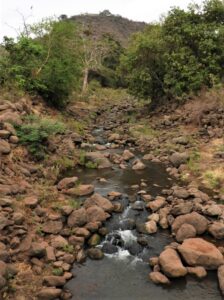 is a tall forest, sustained by groundwater, dominated by evergreen fig and mahogany trees. On the west side of the park, the rocky escarpment of the Rift Valley wall rises steeply to 6,000 ft. Large African baobab trees are scattered on the slopes and dense acacia woodland grows at the base of the Rift wall.
is a tall forest, sustained by groundwater, dominated by evergreen fig and mahogany trees. On the west side of the park, the rocky escarpment of the Rift Valley wall rises steeply to 6,000 ft. Large African baobab trees are scattered on the slopes and dense acacia woodland grows at the base of the Rift wall.
More than 390 species of birds have been documented in the Park, although in the dry season flamingos and other water birds are found in small numbers. Herbivores in the Park include zebra, bushbuck, waterbuck, Grant’s gazelle, impala, Thomson’s gazelle, Cape buffalo, giraffe, hippopotamus, baboon, warthog, and elephant. Predators in the Park include lion, leopard, African wild cat, spotted hyena, jackal, bat-eared fox, serval, honey badger, and mongoose. Cheetah and African golden cat are sighted occasionally.
» posted on Tuesday, September 20th, 2022 by Linda Lou Burton
Quickies: The Lodge
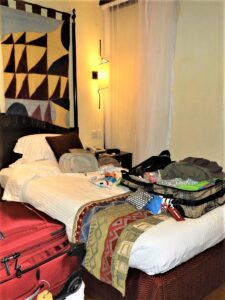 Linda Lou Burton posting from Lake Manyara Serena Safari Lodge, Lake Manyara National Park, Tanzania– 6:15 PM luggage in; 6:15 AM luggage out. Minus out the sleeping time, and the shower time and the poolside time and the dinner time, there was no time left for a sit on our veranda, gazing out across the lake in the valley; breathing in the fresh morning air; listening to the birds. That’s assuming, of course, that the air was fresh and the birds were singing. I was stuffing (not packing) the few things back into my fancy-schmancy palm-tree-brown suitcase that I had bothered to take out; my toothbrush, my morning meds. Passport attached to body; green mosquito-repellent scarf around my neck; hat on head. Rick was stuffing his stuff in the other corner of the room; conversation nil. Both of us were tired, stunned might be a better word; too rushed, the reason why. We needed a break! Alas, Tuesday, September 20, 2022 was not the day we got one. Variety, however, spiced up our lives; surprises at every curve of the road. I guess that’s
Linda Lou Burton posting from Lake Manyara Serena Safari Lodge, Lake Manyara National Park, Tanzania– 6:15 PM luggage in; 6:15 AM luggage out. Minus out the sleeping time, and the shower time and the poolside time and the dinner time, there was no time left for a sit on our veranda, gazing out across the lake in the valley; breathing in the fresh morning air; listening to the birds. That’s assuming, of course, that the air was fresh and the birds were singing. I was stuffing (not packing) the few things back into my fancy-schmancy palm-tree-brown suitcase that I had bothered to take out; my toothbrush, my morning meds. Passport attached to body; green mosquito-repellent scarf around my neck; hat on head. Rick was stuffing his stuff in the other corner of the room; conversation nil. Both of us were tired, stunned might be a better word; too rushed, the reason why. We needed a break! Alas, Tuesday, September 20, 2022 was not the day we got one. Variety, however, spiced up our lives; surprises at every curve of the road. I guess that’s 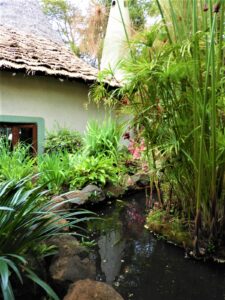 what happens when your day is crammed so full you think you’re gonna die. But, you probably won’t. Die, that is. You’ll just have lots of stuff to think about when you get home.
what happens when your day is crammed so full you think you’re gonna die. But, you probably won’t. Die, that is. You’ll just have lots of stuff to think about when you get home.
The Lodge, first; Lake Manyara Serena Safari Lodge. Some of my photos, and some of theirs. Those round thatch-roofed rondavels were the most unique sleeping accommodations I’ve ever had, and I didn’t get one good picture in our short time there. The dining room, the pool, totally cool! We had three meals with Serena Lodge – dinner, breakfast, and a Bush Lunch, with table under tent cover at the edge of the escarpment, chef’s outdoor grilling station, and patrol guard.
Lake Manyara Serena Safari Lodge, https://www.serenahotels.com/lake-manyara
Tanzania’s towering Mto wa Mbu escarpment provides a remarkable backdrop for Lake Manyara Serena Safari Lodge; a peaceful location amidst the rich wildlife of Lake Manyara National Park. The lake is home to over 300 migratory birds; the Lodge’s architectural motif features swooping avian curves and vibrantly colored wall frescoes depicting bird migratory patterns. Spread along the edge of the cliff for incredible views, accommodations consist of circular, double-story, whitewashed “rondavels” (traditional circular buildings with conical thatched roofs), which include their own small veranda. 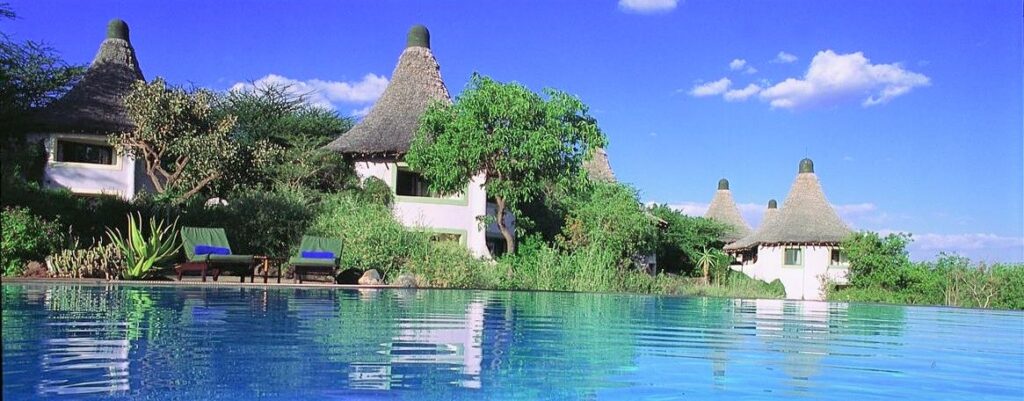
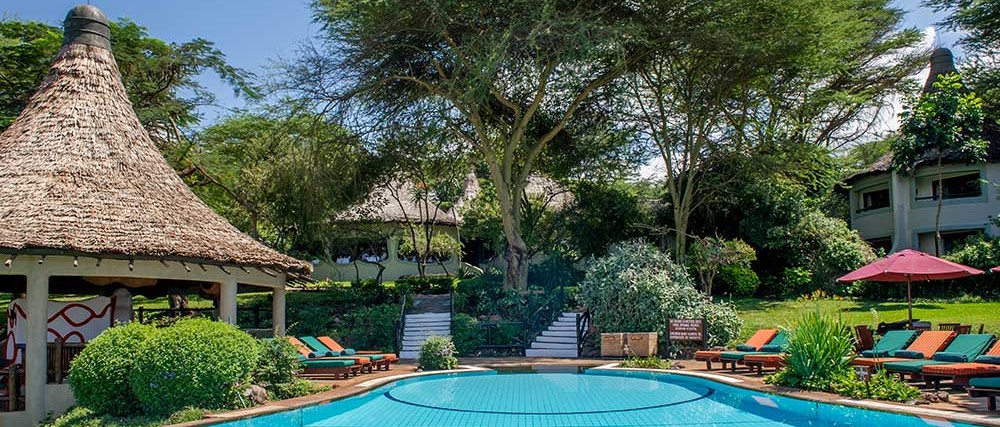 Flamingo Restaurant is designed to replicate a Maasai boma, with swirling primary colors on textured white walls and traditional beadwork, gourds and leatherwork, and includes a veranda with picturesque views. The scenic outdoor terrace and infinity pool offer awe-inspiring lake views; it’s also the venue for cultural dance and music performances, usually held in the evenings. A variety of activities are offered by the Lodge, from village visits and nature walks to biking, jogging, archery, painting, and language and cooking lessons.
Flamingo Restaurant is designed to replicate a Maasai boma, with swirling primary colors on textured white walls and traditional beadwork, gourds and leatherwork, and includes a veranda with picturesque views. The scenic outdoor terrace and infinity pool offer awe-inspiring lake views; it’s also the venue for cultural dance and music performances, usually held in the evenings. A variety of activities are offered by the Lodge, from village visits and nature walks to biking, jogging, archery, painting, and language and cooking lessons.
» posted on Monday, September 19th, 2022 by Linda Lou Burton
Infinity, And Beyond
Linda Lou Burton posting from Lake Manyara Serena Safari Lodge, Lake Manyara National Park, Tanzania– It was 4:40 when our lead vehicle left the pavement. The sign said Lake 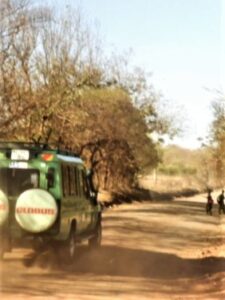 Manyara Serena Safari Lodge – that way. We got wiggly; energy sprouted out of our weariness; we were almost THERE, just a dusty road away. Two boys waved, we waved back; then just past that, our leader turned again; and stopped. Willy pulled beside. A small white building there, surely not our Lodge? What in the world? “This is a museum,” Willy said. “Ben wants you to learn about tanzanite. It’s a gem found in Tanzania.” WHAT? Everyone but me got out; grumbling about this No Warning stop. I was thinking of our Lodge, the infinity pool overlooking the lake, on the very tip edge of the escarpment a thousand feet above the Rift. I was thinking of lions that sleep in trees, and tuk-tuk rides
Manyara Serena Safari Lodge – that way. We got wiggly; energy sprouted out of our weariness; we were almost THERE, just a dusty road away. Two boys waved, we waved back; then just past that, our leader turned again; and stopped. Willy pulled beside. A small white building there, surely not our Lodge? What in the world? “This is a museum,” Willy said. “Ben wants you to learn about tanzanite. It’s a gem found in Tanzania.” WHAT? Everyone but me got out; grumbling about this No Warning stop. I was thinking of our Lodge, the infinity pool overlooking the lake, on the very tip edge of the escarpment a thousand feet above the Rift. I was thinking of lions that sleep in trees, and tuk-tuk rides 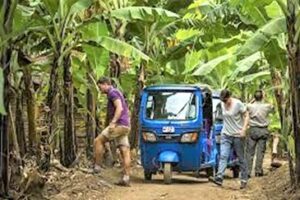 on a banana farm; of lunch in a Swahili canteen. So many things to do in this unique and lovely place; just one night here; so little time. Ben walked to my window, in line with the glare in my eyes. “Lois and Mike have a reservation for a bike ride around the lake this afternoon,” I said in Mama Bear tone. “Oh, I canceled that,” was his reply. “You should go inside, there’s lots of pretty jewelry you can buy.”
on a banana farm; of lunch in a Swahili canteen. So many things to do in this unique and lovely place; just one night here; so little time. Ben walked to my window, in line with the glare in my eyes. “Lois and Mike have a reservation for a bike ride around the lake this afternoon,” I said in Mama Bear tone. “Oh, I canceled that,” was his reply. “You should go inside, there’s lots of pretty jewelry you can buy.”
It was 5:40 when we reached the Lodge, down the steps past the lily pool, into reception, the complimentary juice, the room assignments. “There’s entertainment by the pool at 6,” we were told. I looked at my watch. 6:05. Ben was handing off the keys. “Cottage 1 for you and Rick,” he said. “The closest! Downstairs!” Close, yes, but 16 rocky steps up hill, no rails. Our thatch-roofed rondavel was charming; twin beds-mosquito nets-a patio. Dark almost here; I changed my pants (remember why), grabbed my camera, headed for the pool. Cane got me down the 16 steps; I found a seat at the edge of the edge. Our entertainer was breathing fire. And so was I. 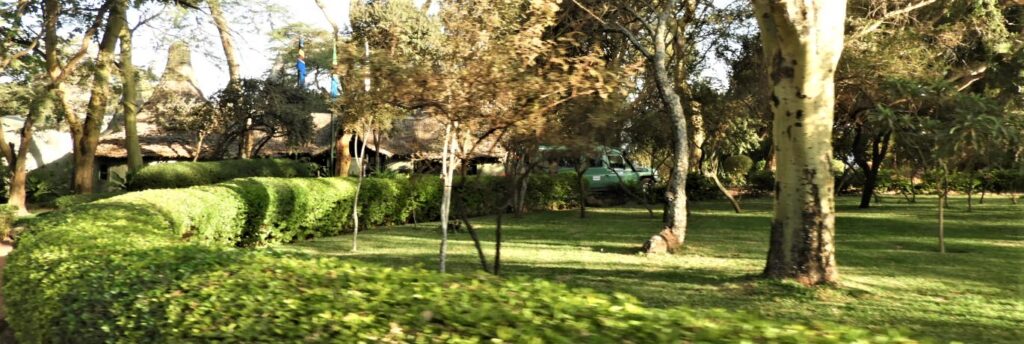
Lake Manyara Serena Safari Lodge, https://www.serenahotels.com/lake-manyara
About Tanzanite: The Blue Gem. The world’s only source of tanzanite is located on a small patch of land at the foothills of Mount Kilimanjaro. The myth is that a local Maasai saw a bolt of lightning come down from the sky and strike the ground turning all the rocks to a shimmering blue. The geological story is that about 585 million years ago as continents shifted, and the Great Rift Valley was created, minerals morphed together to create (what is now known as) tanzanite. The commercial story is that in 1967, when the first stone was “discovered” and determined not to be sapphire, Tiffany & Co christened it “tanzanite” and launched a marketing campaign proclaiming it “the new must-have.” Reasons: it is a thousand times rarer than diamonds, and it is a “single-generation” gemstone due to its limited supply – with the current mining rate, there are only 20 more years of tanzanite in the ground. Hurry up and invest! Tiffany says: Tanzanite can be found on only two places on earth – Tanzania, and Tiffany’s. The Tanzanian places to buy: The Tanzanite Experience, with stores all over – from Arusha to Serengeti to Zanzibar. And Lake Manyara.
The Tanzanite Experience https://www.tanzaniteexperience.com/tanzanite-knowledge/
 A great Tanzanian MINING story, in 2020 a Tanzanian subsistence miner was awarded a government check for 7.74 billion Tanzanian shillings ($3.35 million) for the two largest tanzanite gemstones ever found. Each stone was about the size of a forearm; they were discovered by Saniniu Laizer in one of the tanzanite mines in the north of the country; the mines are surrounded by a wall to control cross-border smuggling of the gemstones.
A great Tanzanian MINING story, in 2020 a Tanzanian subsistence miner was awarded a government check for 7.74 billion Tanzanian shillings ($3.35 million) for the two largest tanzanite gemstones ever found. Each stone was about the size of a forearm; they were discovered by Saniniu Laizer in one of the tanzanite mines in the north of the country; the mines are surrounded by a wall to control cross-border smuggling of the gemstones.
» posted on Monday, September 19th, 2022 by Linda Lou Burton
Getting Our Bearings
Linda Lou Burton posting from Lake Manyara Serena Safari Lodge, Lake Manyara National Park, Tanzania– I’ll call him Ben. That’s not his name, but a way of protecting the guilty, you see. “Ben” was our new guide, and “Ben” seems a fitting name because he never seemed to be where he should have been; nor was he able to get US to where we should have been, when we should have been there. Like this afternoon. There we sat, among the calla  lilies and elegant service of the Arusha Coffee Lodge Garden Terrace, wondering what would happen next. ”Your new guide will be here soon,” was message one. “Someone will come to take you on a tour of the coffee plantation,” was message two, fifteen minutes later. What? “Someone will come to take you on a tour of Shanga” was the third message. I was so annoyed by then I asked “What is Shanga? And when does our guide arrive?” We were done with dessert by now, just sitting, and yawning. “Shanga is a workshop,” was the answer; no reference to our guide at all, or mention of what work went on
lilies and elegant service of the Arusha Coffee Lodge Garden Terrace, wondering what would happen next. ”Your new guide will be here soon,” was message one. “Someone will come to take you on a tour of the coffee plantation,” was message two, fifteen minutes later. What? “Someone will come to take you on a tour of Shanga” was the third message. I was so annoyed by then I asked “What is Shanga? And when does our guide arrive?” We were done with dessert by now, just sitting, and yawning. “Shanga is a workshop,” was the answer; no reference to our guide at all, or mention of what work went on 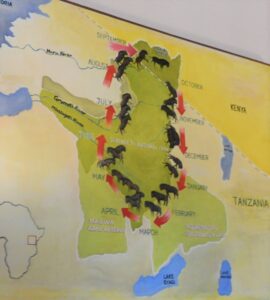 in the workshop. And then, “Please come to the meeting room, just follow me.” Comfortable sofas, a fireplace, a huge map on the wall. But no guide. “Your guide will be here soon.” Eventually, he actually showed. He talked so long we began nodding off, as he quoted facts and figures about the geology ahead, pointing to the map; describing the Great Migration and the Great Serengeti and the greatness of Tanzania. Finally (finally!) we were escorted outside; our luggage now stashed in two new Globus 4x4s; our new drivers ready. Now into a GREEN 4×4; now with driver Willy. That’s his real name by the way; Willy was a gem.
in the workshop. And then, “Please come to the meeting room, just follow me.” Comfortable sofas, a fireplace, a huge map on the wall. But no guide. “Your guide will be here soon.” Eventually, he actually showed. He talked so long we began nodding off, as he quoted facts and figures about the geology ahead, pointing to the map; describing the Great Migration and the Great Serengeti and the greatness of Tanzania. Finally (finally!) we were escorted outside; our luggage now stashed in two new Globus 4x4s; our new drivers ready. Now into a GREEN 4×4; now with driver Willy. That’s his real name by the way; Willy was a gem.
Willy drove the last leg of our journey today; 75 miles from Arusha to our Lake Manyara Lodge. We traveled west on A104, through the Aidai Plains, in the basin of the Great Rift Valley. We turned northwest at Makuyuni, where we slowed to view a colorful, bustling market. Then through the village of Mto Wa Mbu, and the lush banana plantation, before climbing a thousand feet out of the valley to the edge of the escarpment, and our lodge.
Attention getters this afternoon – good paved highways, properly striped and maintained; hillsides covered with heavy duty power lines and communications towers; large black water tanks; brightly painted Jesus vans; and trucks, trucks, trucks. Oh yes, a baboon hiking down the highway to grab a banana, according to Willy. Tanzania has a very different vibe.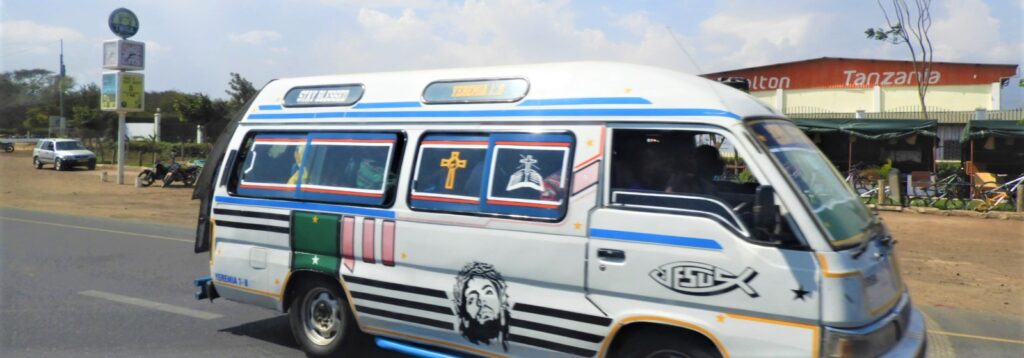
Next Post: Infinity, and Beyond
» posted on Monday, September 19th, 2022 by Linda Lou Burton
It Wasn’t Exactly A Bus
 Linda Lou Burton posting from Arusha, Tanzania– Confusion. Inside Namanga’s Border Control Office, confusion reigned in signs and lines; blurred. Somebody pushed me out of one line into another, pulled me maybe. I had everything in hand: passport, Tanzanian visa, Yellow Fever Card, COVID documents. Cane in the other hand, leaning, wobbly. At the first window a man took my passport and simply walked away with it! Another push, someone grabbed my arm, another line. The gang was split, everyone confused, different lines; I was pushed again, to the front of a line, the counter. Another man, smiling at me. “You look confused,” he said. “Are you enjoying your visit?” “And you look very handsome,” I replied, “and not confused at all. So maybe you can tell me what is going on.” This made him laugh. I can’t tell you what happened next, but somehow everything I needed was stamped, signed, recorded, and my passport back in my possession. I staggered out of the room, a young man took my arm, oh yes, our driver, the one taking us to Arusha, on the big bus. “I need a restroom first,” I said. He led me around the corner to a room with open door; three stalls, one stall with a hole-in-the-floor design; the next with a toilet but no door; the third with a door but a toilet with no seat. No paper anywhere. I chose the stall with the door; walked out with a wet spot on the back side of my pants. The driver led me towards our new vehicle; not a spacious bus, but a minivan! While we were inside our luggage was moved from the 4x4s; luggage for nine people now in a van, barely space for nine to
Linda Lou Burton posting from Arusha, Tanzania– Confusion. Inside Namanga’s Border Control Office, confusion reigned in signs and lines; blurred. Somebody pushed me out of one line into another, pulled me maybe. I had everything in hand: passport, Tanzanian visa, Yellow Fever Card, COVID documents. Cane in the other hand, leaning, wobbly. At the first window a man took my passport and simply walked away with it! Another push, someone grabbed my arm, another line. The gang was split, everyone confused, different lines; I was pushed again, to the front of a line, the counter. Another man, smiling at me. “You look confused,” he said. “Are you enjoying your visit?” “And you look very handsome,” I replied, “and not confused at all. So maybe you can tell me what is going on.” This made him laugh. I can’t tell you what happened next, but somehow everything I needed was stamped, signed, recorded, and my passport back in my possession. I staggered out of the room, a young man took my arm, oh yes, our driver, the one taking us to Arusha, on the big bus. “I need a restroom first,” I said. He led me around the corner to a room with open door; three stalls, one stall with a hole-in-the-floor design; the next with a toilet but no door; the third with a door but a toilet with no seat. No paper anywhere. I chose the stall with the door; walked out with a wet spot on the back side of my pants. The driver led me towards our new vehicle; not a spacious bus, but a minivan! While we were inside our luggage was moved from the 4x4s; luggage for nine people now in a van, barely space for nine to 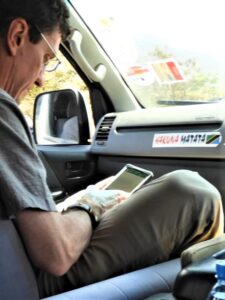 sit! Mike and Lois were standing there; we scrambled into the front seats. “First come!” we said, unwilling to politely stuff ourselves in the back row. Mike took the front seat and busied himself on his phone. Lois and I crowded together; our luggage and backpacks squashed between our knees and the driver’s seatback. “My pants are wet” I whispered. We started laughing then; the restroom, the crowd, the confusion; the Hukana Matata sign across the dash. “No worries!” we laughed. The door of the van was open; two laughing women visible; a crowd gathered; arms reached inside with beaded goods, “Ten Dollar! Ten Dollar! Ten Dollar!” We stopped laughing; shook our heads, NO, please NO. NO. NO. Otis and Venita arrived; Otis attempted to negotiate a trade as Venita urged him to get in the van, NOW! Ed and Maureen and Judy arrived; slipped past the insistent vendoring crowd. Where was Rick? Where was Abdi? Still inside. Rick had his visa on his phone, but he didn’t take the paper copy in. Abdi helped; persuading the stick-by-the-rules governmental staff to print it from the phone; persuading them not to charge Rick $6 per page for the six pages it took, slowly, slowly (pole, pole). Then finally, everyone inside; goodbye to Abdi; the door of our “not exactly a bus” was closed. We headed for Arusha.
sit! Mike and Lois were standing there; we scrambled into the front seats. “First come!” we said, unwilling to politely stuff ourselves in the back row. Mike took the front seat and busied himself on his phone. Lois and I crowded together; our luggage and backpacks squashed between our knees and the driver’s seatback. “My pants are wet” I whispered. We started laughing then; the restroom, the crowd, the confusion; the Hukana Matata sign across the dash. “No worries!” we laughed. The door of the van was open; two laughing women visible; a crowd gathered; arms reached inside with beaded goods, “Ten Dollar! Ten Dollar! Ten Dollar!” We stopped laughing; shook our heads, NO, please NO. NO. NO. Otis and Venita arrived; Otis attempted to negotiate a trade as Venita urged him to get in the van, NOW! Ed and Maureen and Judy arrived; slipped past the insistent vendoring crowd. Where was Rick? Where was Abdi? Still inside. Rick had his visa on his phone, but he didn’t take the paper copy in. Abdi helped; persuading the stick-by-the-rules governmental staff to print it from the phone; persuading them not to charge Rick $6 per page for the six pages it took, slowly, slowly (pole, pole). Then finally, everyone inside; goodbye to Abdi; the door of our “not exactly a bus” was closed. We headed for Arusha.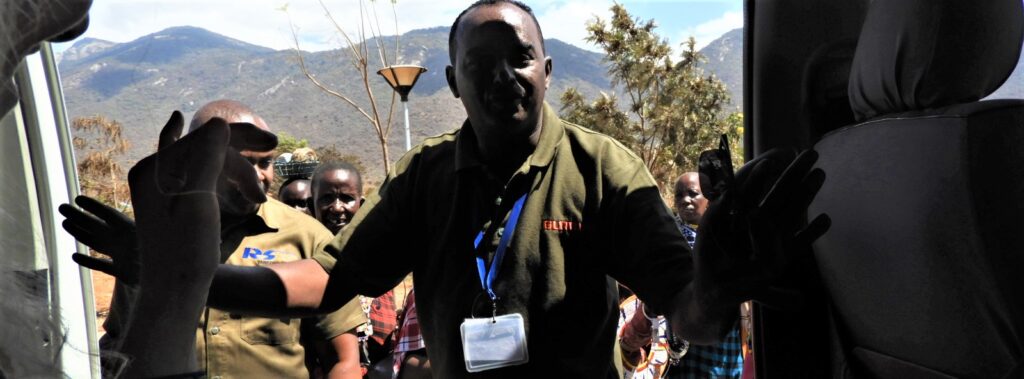
Arusha, Tanzania has a population of more than 400,000; another 300,000+ in the area surrounding. On the eastern edge of the Great Rift Valley, it is near Serengeti National Park, the Ngorongoro Conservation Area, Lake Manyara National Park, Olduvai Gorge, Tarangire National Park, Mount Kilimanjaro, and Mount Meru in the Arusha National Park. At an elevation of 4,600 feet, Arusha’s climate is relatively cool and dry. Colleges and universities located here include the National College of Tourism, about which we will hear more this week. We reached our lunch stop and driver-vehicle switching place at noon; the Arusha Coffee Lodge, on a working coffee plantation. Here’s this 70-mile leg of today’s journey.
Next Post: Getting Our Bearings
Garden Luncheon, Arusha Coffee Lodge https://www.elewanacollection.com/arusha-coffee-lodge/dining
» posted on Monday, September 19th, 2022 by Linda Lou Burton
Going to Namanga
Linda Lou Burton posting from Namanga, Kenya– ”You’ll have a nice big bus from the 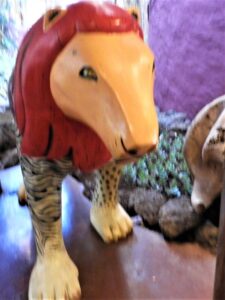 border to Arusha,” Abdi informed us at breakfast. “You all get to ride together.” We cheered, and headed out, past the Simba lion that guarded the door of the dining room, across the timbered bridge and past the sign that warned of monkey bites; ready to ride. The Lodge at Lake Manyara was our destination today, Tanzania! To a person we were glad to be leaving Amboseli’s dust for the promise of the beautiful blue waters of a lake. That, however was almost 200 miles away, 5 hours as the crow flies, but we were not flying. We had many hurtles ahead; many stops; many waits. Many changes of vehicle, and personnel. From our Amboseli Lodge our two Globus drivers, Amos, and the one I’d never even met, would take us to Namanga, the last leg of our journey in Kenya.
border to Arusha,” Abdi informed us at breakfast. “You all get to ride together.” We cheered, and headed out, past the Simba lion that guarded the door of the dining room, across the timbered bridge and past the sign that warned of monkey bites; ready to ride. The Lodge at Lake Manyara was our destination today, Tanzania! To a person we were glad to be leaving Amboseli’s dust for the promise of the beautiful blue waters of a lake. That, however was almost 200 miles away, 5 hours as the crow flies, but we were not flying. We had many hurtles ahead; many stops; many waits. Many changes of vehicle, and personnel. From our Amboseli Lodge our two Globus drivers, Amos, and the one I’d never even met, would take us to Namanga, the last leg of our journey in Kenya.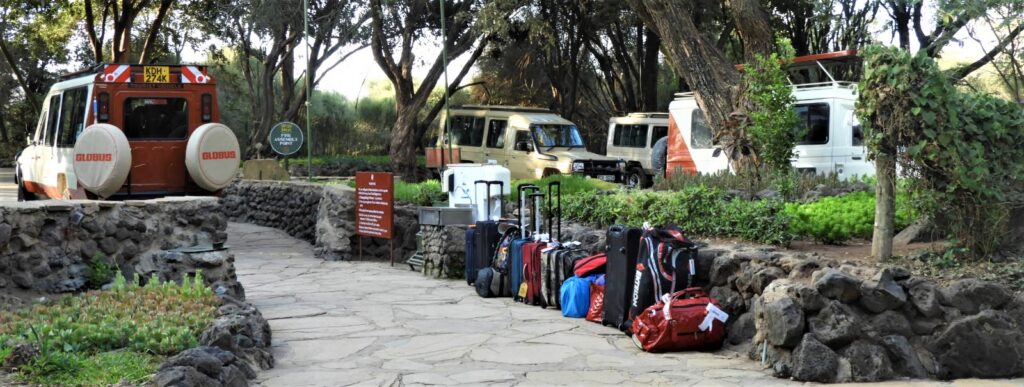
Namanga is a border town, split between Kenya and Tanzania; about 100 miles south of Nairobi and 70 miles north of Arusha; its population is somewhere upwards of 10,000. Tourism supports the town – anyone from Nairobi going to Mt Kilimanjaro passes through the Namanga border crossing. Hills and mountains surround the town – Mt Kili is visible from there; so is Ol Doinyo Orok mountain, also called the Black Mountain, sacred to the Maasai; stretching to the north are the Maparasha Hills. The economy of Namanga also includes the import-export business; trucks haul goods back and forth non-stop between the two countries. Namanga’s main population is Maasai, Kikuyu second; other ethnicity groups include Kama, Somali, Borana, a mixed population.
So how did it go? What did we see between our 7:15 departure and 9:30 when we walked into the Namanga One Stop Border Post? Our route was C103 west after departing Amboseli NP, unpaved and dusty red for 50 miles. Take a look.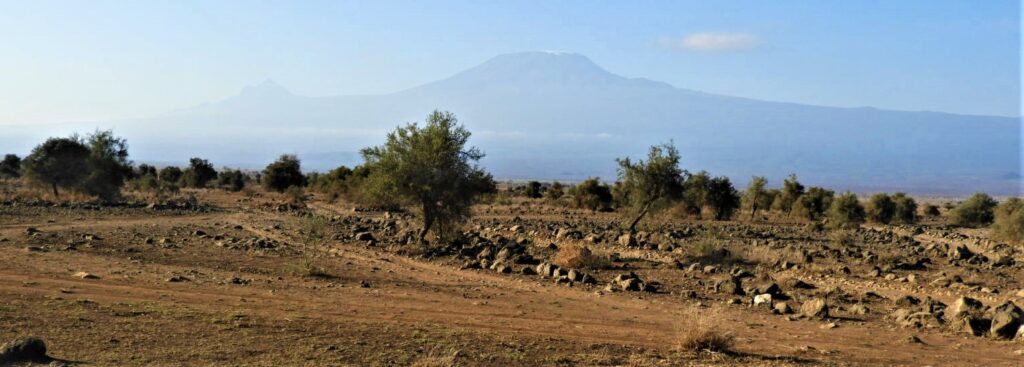
Next Post: It Wasn’t Exactly A Bus
» posted on Sunday, September 18th, 2022 by Linda Lou Burton
The Dimming Of The Day
Linda Lou Burton posting from Amboseli Serena Safari Lodge, Amboseli National Park, 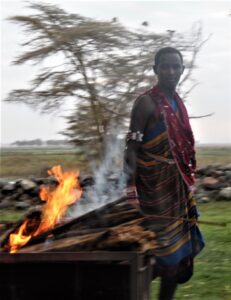 Kenya– It was our last night in Kenya, our last night with Abdi. Tomorrow we crossed the border into Tanzania; tomorrow we got new drivers; a new guide. The gang of us was seated semi-circle, our chairs in perfect position on the lawn of the Lodge to watch the sun set on mighty Kilimanjaro in a blaze of orange and red, relaxing at the end of our safari day with G&T in hand. Sundowners: a British tradition. Tonight however, the sunset was missing.
Kenya– It was our last night in Kenya, our last night with Abdi. Tomorrow we crossed the border into Tanzania; tomorrow we got new drivers; a new guide. The gang of us was seated semi-circle, our chairs in perfect position on the lawn of the Lodge to watch the sun set on mighty Kilimanjaro in a blaze of orange and red, relaxing at the end of our safari day with G&T in hand. Sundowners: a British tradition. Tonight however, the sunset was missing.
The mountain was socked in, invisible. The colors tonight, beyond the blaze of the campfire, beyond the green of the swamp and the brown dust of the fields beyond that, was gray; a gloomy look. Abdi spoke of new friendships, new insights gained; urging us to tell others, back home, about Kenya. Amos spoke, reminding us of realities we’d witnessed for ourselves in Amboseli; the images of the day flashed through my mind, the contrasts. 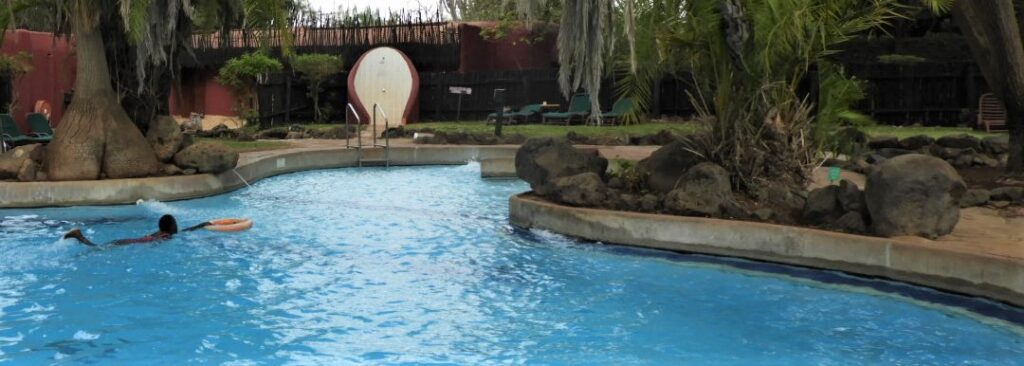
So much to think about, so much to remember. The gang of us on safari, plus our guide Abdi standing, driver Amos 3rd from right. 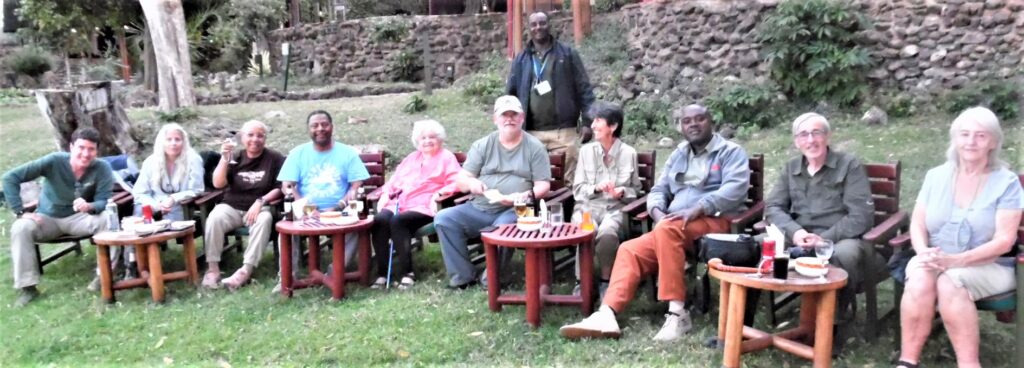
A Brief History of Amboseli National Park
Amboseli National Park is 97,117 acres in size at the core of a 1,976,843-acre ecosystem that spreads across the Kenya-Tanzania border. The park protects two of five main swamps, and includes a dried-up Pleistocene lake and semiarid vegetation. The local people are mainly Maasai.
It was 1883 when European Jeremy Thompson first penetrated the Maasai region known as Empusel (meaning ‘salty, dusty place’ in Maa); he was astonished by the fantastic array of wildlife and the contrast between the arid areas of the dry lake bed and the oasis of the swamps, a contrast that persists today. Amboseli was set aside as the Southern Reserve for the Maasai in 1906, but returned to local control as a game reserve in 1948. Gazetted a national park in 1974 to protect the core of this unique ecosystem, it was declared a UNESCO site in 1991. In 2005, Kenyan President Mwai Kibaki declared that control of the park should pass from the Kenya Wildlife Service to the Olkejuado County Council and the Maasai tribe; legal challenges are currently in court. The degazetting would divert park admission fees directly to the county council with shared benefits to the Maasai immediately surrounding the park.
» posted on Sunday, September 18th, 2022 by Linda Lou Burton
Olasiti Village
Linda Lou Burton posting from Olasiti Village, Amboseli National Park, Kenya– I met a Maasai chief today. His name is Benson Meoli. Our visit to his village was one of the perks, or 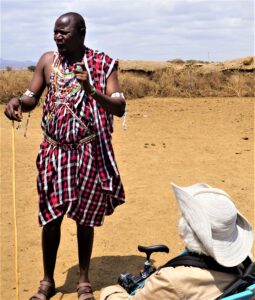 experiences, offered through Serena Amboseli Lodge, for a fee; an opportunity to learn more about Maasai culture. The Village was barely a 15-minute drive across the dusty landscape (once we exited the swampy lushness of the Lodge); Abdi had directed, ahead of time, that a chair awaited me. It was hot, and dusty there, one lone tree offering a bit of shade; after introductions Benson quickly dispatched others to bring more chairs, till everyone was comfortably seated in the meager shade. “You can ask him anything,” Abdi said, as Benson stood, a splendid man, patient and composed, awaiting his turn to speak.
experiences, offered through Serena Amboseli Lodge, for a fee; an opportunity to learn more about Maasai culture. The Village was barely a 15-minute drive across the dusty landscape (once we exited the swampy lushness of the Lodge); Abdi had directed, ahead of time, that a chair awaited me. It was hot, and dusty there, one lone tree offering a bit of shade; after introductions Benson quickly dispatched others to bring more chairs, till everyone was comfortably seated in the meager shade. “You can ask him anything,” Abdi said, as Benson stood, a splendid man, patient and composed, awaiting his turn to speak.
Before our visit ended, he had talked about the Maasai spirit; the belief in community. He gave examples of responsibility, bravery, health. There were demonstrations (how to build a fire, together, each person playing a significant part). There were others who spoke (the village doctor; the purity of their diet; no arthritis, lean physiques). We were shown how the round straw-roofed houses are built (sticks for the frame, plastered with cow dung, no windows); we were invited to go inside.
And we were invited to join the dance. Of course they danced for us; the men the famous Maasai jumping dance, as tourists expect; the women paraded in their colorful garb, singing strong. Lois joined them, I stepped forward too, with cane of course; someone quickly took my hand. Mike and Otis joined the jumping dance; Venita and Judy admired the baby, Benson’s son, we were told, a beautiful boy. Rick was given an honorary Maasai name; Ed and Maureen got photos, all around.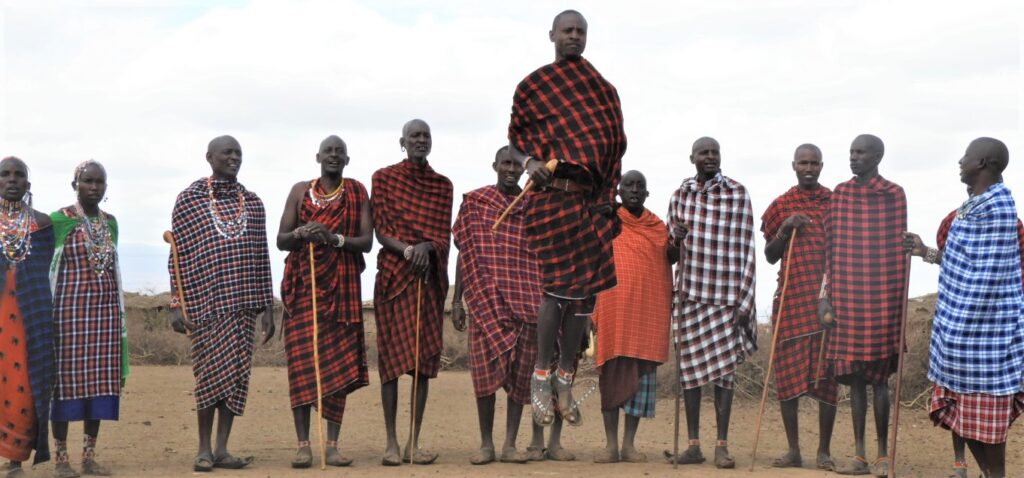
And then, the sell. The women spread their wares across the dust; blankets covered in beads, elaborate decorations for the neck, the arms; bookmarks designed as birds, giraffes; magnets for the fridge. A visit to the school; the children came today, a holiday, especially to sing for us. The pressure push was strong, but underneath, the message clear.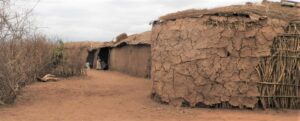
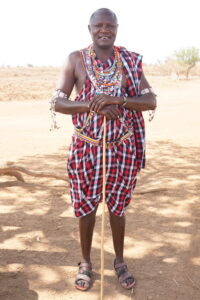 Olasiti Village is in trouble. Their cattle are dying, like the zebras we saw the day before. Their cattle, their livelihood, are dying of thirst. There is no life without water, and the water is disappearing, fast. For four years now, the rains have failed to come. The village well, their one and only water source, connects to the aquifer that connects to the mountain that looms above, and the glaciers on that mountain are disappearing, fast. Behind all the niceties, and smiles, and beaded charms, these people need help.
Olasiti Village is in trouble. Their cattle are dying, like the zebras we saw the day before. Their cattle, their livelihood, are dying of thirst. There is no life without water, and the water is disappearing, fast. For four years now, the rains have failed to come. The village well, their one and only water source, connects to the aquifer that connects to the mountain that looms above, and the glaciers on that mountain are disappearing, fast. Behind all the niceties, and smiles, and beaded charms, these people need help.
Benson Meoli, the Maasai chief I met today, asks that we do what we can.
Olasiti Village, Kenya https://www.olasitimaasai.com/

